

















TLW's Pshrinkscope™ (Pshrink Historyscope) |
By T.L. Winslow (TLW), the Historyscoper™ |
© Copyright by T.L. Winslow. All Rights Reserved. |
Original Pub. Date: Mar. 27, 2013. Last Update: Jan. 14, 2021. |









Westerners are not only known as history ignoramuses, but double dumbass history ignoramuses when it comes to Psychology and Psychiatry history. Since I'm the one-and-only Historyscoper (tm), let me quickly bring you up to speed before you dive into my Master Historyscope.
Humans used Psychoactive (Psychotropic) Drugs as far back as 5K-10K years, incl. hashish, opium, coca leaves et al. They also performed Trepanning (Trephination) (Trephining) on human skulls.

About 1500 B.C.E. the Ebers Papyrus is created in Luxor, Thebes, Egypt, describing diagnosis and treatment of various medical ailments incl. depression and dementia, mentioning that the heart is the center of the blood supply and all bodily fluids, and listing 877 drug prescriptions; discovered in 1873-4 by German Egyptologist Georg Mortiz Ebers (1837-98).

About 400 B.C.E. 60-y.-o. Hippocrates of Cos (-460 to -377) of the island of Cos in Greece becomes the first person to enter the profession of medicine, teaching that diseases have natural causes, and theorizing that mental disorders may be caused by physiological abnormalities; Aristotle later calls him the "great physician"; "Primum non nocere" ("The first rule is do no harm"); he determines that the male contribution to a child's heredity is carried in the semen - matriarchial religions are f-ed? He leaves the Hypocritical Kevorkian, er, Hippocratic Oath (attributed to him later?): "I swear by Apollo, the physician, by Aesculapius, by Hygieia, Panacea, and all the gods and goddesses... The regimen I adopt shall be for the benefit of my patients according to my ability and judgment, and not for their hurt or for any wrong. I will give no deadly drug to any, though it be asked of me, nor will I counsel such, and especially I will not aid a woman to procure abortion..." He also writes Aphorisms; "Life is short, and Art is long" (Vita breva, Ars longa) - is there a doctor in the Acropolis? He leaves the soundbyte "Let food be thy medicine and medicine be thy food."
In 394 B.C.E. Greek physician Erasistratus (-304 to -250) diagnoses Seleucis I Nicator's eldest son Antiochus I Soter as lovesickness, and when asked who it is, he claims it's his own wife, causing Seleucus I to pontificate that he should give her up, whereupon he reveals that it's really his own hot new queen Stratonice, causing Seleucus I to give her up; Erasistratus goes on to co-found the Medical School of Alexandria with Herophilus (-335 to -280); after doing the first dissections (vivisections)? Erasistratus studies the brain, distinguishing between the cerebrum and cerebellum; Herophilus studies the nervous system, distinguishing between sensory and motor nerves.

In 347 B.C.E. big brain Greek philosopher Plato (-427 to -347) dies after suggesting that the brain is the seat of mental processes, leaving the soundbyte: "God created the soul before the body and gave it precedence both in time and value, making it the dominating and controlling partner." (Timaeus)

In 322 B.C.E. big brain Greek philosopher Aristotle (Gr. "best of all") of Stagira (-384 to -322) dies, leaving Metaphysics, about existence, causation, form, matter, mathematical objects, and God the Prime Mover, it will either make you or break you, good luck; he also left De Anima (On the Soul), which first mentions the Tabula Rasa view of the mind as starting out a blank slate.
In 43 B.C.E. Greek physician Themison of Laodicea (-123 to -43), founder of the Methodic School of Medicine dies after becoming the first physician to use leeches, and being accused by Soranus of cruelty toward mental patients incl. chains, darkness, and food-drink deprrivation; Juvenal satirizes him, claiming that he killed more patients than he cured?
About 50 C.E. Roman medical encyclopedist Aulus Cornelius Celsus dies, leaving De Medicina (8 vols.), which incl. Bk. III that covers mental diseases.
In the 3rd cent. C.E. Artemidorus Daldaianus (of Daldis) (Ephesius) flourishes, leaving Oneirocritica (Oneirokritikon) (Gr. "The Interpretation of Dreams") (5 vols.), becoming the earliest known Greek work on the subject.

In 397-8 C.E. St. Augustine of Hippo (354-430) pub. Confessions, in which he formulates a psychology that almost recognizes the subconscious, along with an "inner sense".
In 705 C.E. the first psychiatric (mental) hospital is built by Muslims in Baghdad, followed by Cairo in 800, and Damascus in 1270.
About 750 C.E. the so-called Islamic Golden Age begins (ends 1258).
About 900 C.E. Persian Muslim physician-scientist Abu Zayd Ahmed ibn Sahl al-Balkhi (850-934) invents the concept of mental hygiene, with the soundbyte: "If the psyche gets sick, the body may also find no joy in life and may eventually develop a physical illness."

About 1030 Persian Shiite Muslim scholar Abu al-Rayhan Muhammad ibn Ahmad Al-Biruni (973-1048) determines reaction time using the first experimental method in psychology?

In June 1037 Persian polymath philosopher-physician Ibn Sina (Avicenna) (Abu Ali al-Hussain ibn Abdallah ibn Sina) dies, leaving Al-Qanun fi al-Tibb (Canon of Medicine) (5 vols.) (1025) (1M words), which synthesizes Greek and Arab medicine, basing medicine on experiment and reason, going on to dominate European medicine until the mid-17th cent. He also leaves Kitab al-Shifa (Kitab ash-Shifa bi ta'rif huquq al Mustafa) (Book of Healing by the Explanation of the Rights of the Chosen One) (AKA Sufficientia) (18 vols.), an attempt to describe all scientific and philosophic knowledge; also Kitab al-Najat (Book of Salvation), an abridged vers. of the preceding, giving the "flying man argument" for the distinction between the body and soul, which must be strong enough to ensure its individuality, but weak enough to allow for its immortality; he also founds physiological psychology for the treatment of illnesses involving emotions, developing a system for associating changes in pulse rate with inner feelings, and developing the Tabula Rasa concept beyond Aristotle.
In 1240 Franciscan scholar Bartholomew of England (Bartholomeus Anglicus) (1202-72) pub. On the Properties of Things (De Proprietatibus Rerum) (19 vols.), a forerunner of the encyclopedia, incl. a dissertation on the brain, recognizing that mental disorders can have a physical or psychological cause.
In 1247 Bethlehem Royal Hospital in Bishopsgate outside the wall of London is founded as the priory of the new Order of St. Mary of Bethlem by Goffredo de Prefetti of Italy, bishop-elect of Bethlehem to collect alms for the Crusades; it begins to be called a hospital in 1330, and by 1377 (1403?) after the English govt. secularizes it, it begins admitting the insane; by the 14th cent. it becomes known as Bedlam; in 1547 it is acquired by the City of London, operating until 1948; it is now part of the British NHS Foundation Trust.
In 1258 the fizzling Islamic Golden Age becomes kaput with the sack of Baghdad by the Mongols.

About 1270 German friar-scientist Witelo (1230-1313), pub. Perspectiva, a work on optics based on Alhazen, containing speculations on psychology, nearly discovering the subconscious.

In 1295 Duns, Scotland-born brain man John Duns Scotus (1265-1308) pub. Sententiae, in which he examines the issue of "mental content", the feature of mental acts in virtue of which each has the character it does qua mental act.
The Black Death (the original Darth Vader) rockets through Europe's Internet with breathtaking speed? In Oct. 1347 a Genoese trading fleet arrives in Messina, Sicily carrying the Black Death (Bubonic Plague) (Yersinia pestis bacteria), carried by fleas from rats; it also arrives in Egypt, Syria, and Cyprus; by 1351 it kills 20M-30M in Europe (a third of Europe's pop., and up to 60% in some areas), and 75M worldwide by 1361; world. pop. decreases from 450M to 350M-375M by 1400; Europe takes 150 years to return to 1347 pop. levels; it ravages China, halving its pop. from 123M in 1200 to 65M in this cent.; lucky America is not affected, but not toughened up by it either?; rats didn't really spread it, because it spread too fast from person to person? On Sept. 26, 1348 Pope Clement VI issues the bull Quamvis Perfidiam, attempting to dispel the rumor that Jews caused the Black Death by poisoning wells, saying that they too are suffering from the plague, but he is ignored. In summer 1349 the Great Plague reappears in Paris, where it peaks, killing up to 800 a day, and spreads to Picardy, Flanders, and the Low Countries; also in the summer it reappears in London, and spreads to Ireland, killing 25% of the pop. within a year; by the middle of the year half of the pop. of Venice is killed; by the end of the year half of England's pop. is killed, and a truce with France is called; the plague spreads to Norway when an English ship full of corpses floats into Bergen, and reaches Elbing (Elblag), Poland on Aug. 24; the Church and its credibility being challenged head-on, the main solution offered is by the Flagellants, who appear in force all over Europe (especially Germany), torturing themselves publicly, and proclaiming that the Second Coming is 33.5 years away (I been a bad, bad boy, so tan my sinful hide?), while causing trouble for Jews, the rich, the Church, and finally themselves (besides all the wounds), causing Pope Clement VI to pub. a bull condemning them on Oct. 20; "Many persons, and even young children were soon bidding farewell to the world, some with prayers, others with praises on their lips."
In 1350-1 the Great Plague begins clearing, leaving a depopulated Europe where the deck is reshuffled and the entire social order is thrown up for grabs. The intelligentisa begin to smell a rat in the divine pretensions of the Church, and launch the timeless look at the ancient pagan past called the Renaissance via their Greek scholar friends in Constantinople, no longer being satisfied with Arab translations but learning ancient Greek for themselves; meanwhile the workers see the class struggle clearly now, the rain is gone.

After 1350 English authorities regard mental illness as demonic possession, treating patients with exorcism and torture incl. hydrotherapy (ice-cold baths) and trepanation. Meanwhile in France in Aug. 1392 en route to Brittany with his army, French king (since 1380) Charles VI the Beloved (1368-1422) goes mad and kills four knights in the forest of Le Mans, and almost kills his brother Louis of Orleans, going on to become more and more mad, with torture not an option, leading to his brothers stripping him of political power, which results in a power struggle between Louis of Orleans and John the Fearless, duke of Burgundy that makes it ripe for takeover by the English, see William Shakespeare's play "Henry V".
About 1400 after the Great Plague ended, Renaissance Humanism gets off to a fast start, reviving classical learning and speculative inquiry, displacing Scholasticism as W Europe's main philosophy, and taking the monopoly of learning from churchmen, letting laymen into the equation, which soon causes the very basis of Church dogma and tradition to come under the microscope; too bad, by the middle of the cent. the pendulum swings, bringing Witch Mania, which causes thousands of mostly women to be executed until the late 17th cent.


In 1590 German scholastic philosopher (believer in witchcraft) Rudolph (Rudolf) Goclenius (Gockel) (Göckel) (1547-1628) coins the term "psychology"; really coined in the 1530s by Croatian humanist Marko Marulic (1450-1524)?


In 1621 Oxford U. scholar Robert Burton pub. The Anatomy of Melancholy under the alias Democritus Junior, quoting works by Jewish physician Isaac Israeli (855-955); "I write of melancholy, by being busy to avoid melancholy. There is no greater cause of melancholy than idleness, no better cure than business"; "The only book that ever took me out of bed two hours sooner than I wished to rise" (Samuel Johnson).

In 1637 French brain man ("Father of Modern Philosophy") Rene Descartes (1596-1650) pub. the epoch-making Discourse on Method (Discourse on the Method of Rightly Conducting One's Reason and Seeking Truth in the Sciences, which expounds the technique of divide and conquer; it contains the three appendices (Qui Sont des Essais de Cete Methode): La Dioptrique, advancing the corpuscular theory of light; Les Monde ou Traite (Traité) de la Lumiere (Lumière) (1633), on cosmology; La Geometrie (1637), founding the field of analytic geometry and introducing the concept of a mathematical function. In 1644 he pub. Principia Philosophiae (Principles of Philosophy) in Amsterdam, containing the ultimate philosophy soundbyte "Je pense, donc je suis" ("I think, therefore I am"); too bad, it kowtows to the Roman Catholic 1616 anti-Copernican decree by stating that "I want what I have written to be taken simply as an hypothesis, which is perhaps far removed from the truth"; declares that all motion is relative, thus the Earth can be considered at rest like the Church dictates, drawing criticism from Newton; also that bodies can act on each other only through contact; famous for its diagrams of vortices in which planets are carried in the whirlpool of subtle matter around the Sun - don't try to fight it, don't try and save me, she's a woman in love? In 1662-4 he posth. pub. Treatise on the World, proposing the Dualistic Model of Reality, physical and mental.
In 1656 Louis XIV of France founds Pitie-Salpetriere (Pitié-Salpêtrière) Hospital, AKA Hospital (or Hopital) Gen. in Paris as a combo hospital, factory, and poorhouse, growing to the world's largest hospital by 1789, with 10K patients, mainly hos and mental cases.

In 1664 English physician Thomas Willis (1621-75) pub. Cerebri Anatome (Anatomy of the Brain), describing his research into the anatomy of the brain along with his discovery of the Circle of Willis, and coining the term "neurology"; traces the optic tract to the thalamus. In 1667 he pub. Pathologicae Cerebri et Nervosi Generis Specimen (Pathology of the Brain), on the pathology and neurophysiology of the brain, developing a new theory of the cause of epilepsy; contains the first account of the effects of the late stage of syphilis on the brain. In 1672 he pub. De Anima Brutorum (Two Discourses Concerning the Soul of Brutes, Which is that of the Vital and Sensitive of Man), the first English work on medical psychology, attributing psychology to brain function, and connecting the senses with the brain, but advising physicians to hit mental patients over the head with sticks.

In 1677 Amsterdam-born Jewish philosopher Baruch (Benedict de Spinoza) (1632-77) dies, leaving Ethics, Demonstrated in Geometrical Order; Pt. 2 focuses on the human mind and body, disputing Rene Descartes and arguing that they are one; Pt. 3 attempts to show that moral concepts incl. good, evil, virtue, and perfection have a basis in human psychology.

In 1689-90 Somerset-born English philosopher John Locke (1632-1704) pub. An Essay Concerning Human Understanding (4 vols.), which describes the mind at birth as a Tabula Rasa that is later filled with experience, becoming the first to define the self via a continuity of consciousness.

In 1701 Leipzig, Germany-born philosopher Gottfried Wilhelm von Leibniz (1646-1716) pub. the Law of Continuity, which he applies to human psychology, becoming the first to postulate an unconscious mind; he also introduces the concept of threshold.

In 1710 Irish philosopher-mathematician and Anglican bishop of Cloyne (County Cork) George Berkeley (1685-1753) (namesake of Berkeley, Calif.) pub. his magnum opus A Treatise Concerning the Principles of Human Knowledge, which attempts to prove Immaterialism AKA Subjective Idealism, which holds that the outside world is composed solely of ideas; "Ideas can only resemble ideas"; "To be is to be perceived."

In 1724 after being freaked-out by the 1692-3 Salem Witch Trials, Puritan New England minister Cotton Mather (1663-1728) advances physical rather than demonic explanations for mental illnesses.

In 1732 German philosopher Christian Wolff (1679-1754) pub. Psychologia Empirica, followed in 1734 by Psychologia Rationalis, popularizing the term "psychology".

In 1739 Edinburgh, Scotland-born empiricist philosopher David Hume (1711-76) ("widely regarded as the greatest who has ever written in the English language") pub. his magnum opus A Treatise of Human Nature (2 vols.) (1739-40), which denies the existence of innate ideas, claiming that all contents of mind are solely built from sense experiences, and dissing Rene Descartes, claiming that desire rather than reason governs human behavior, pioneering Logical Positivism (Empiricism); too bad, it is ignored by the public, causing him to call it "dead-born", until Immanuel Kant credits him with awakening him from "dogmatic slumbers" about 1770; "There is more to be learned from each page of David Hume than from the collected philosophical works of Hegel, Herbart and Schleiermacher taken together" (Arthur Schopenhauer).

In 1758 English physician William Battie (Batty) (1703-76) pub. Treatise on Madness, the first lengthy treatment of mental illness, suggesting treatments for mental patients housed in asylums, and advocating the same treatments for the rich and poor, helping make psychiatry a respectable specialty; in 1764 he becomes the first psychiatrist pres. of the Royal College of Physicians.
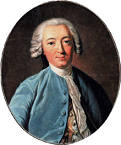
In 1758 French philosopher Claude Adrien Helvetius (Helvétius) (1715-71) pub. his magnum opus De l'Esprit (Essays on the Mind); which declares that all human faculties are attributes of mere physical sensation, and that the only real motive is self-interest, and therefore there is no good and evil, only competitive pleasures, hence hedonism rules; pisses-off the theological faculty of the Sorbonne, who publicly burn his work in 1759, causing him to travel in England, then Germany, where Frederick II the Great receives him with honor, allowing him to retire to his country estate back in France.

In July 1781 German philosopher Immanuel Kant (1724-1804) pub. The Critique of Pure Reason (Die Kritik der Reinen Vernunft) in Riga, rejecting David Hume's extreme empiricism, and proposing that there is more to knowledge than bare sense experience, distinguishing between "a posteriori" and "a priori" knowledge, the former being derived from perception, hence occurring after it, and the latter being a property of thought, independent of experience and existing before it - I know what I want to say but it takes so many pages to say it?

In Aug. 1793 French physician Philippe Pinel (1745-1826) was appointed physician in charge of Bicetre Hospital in S Paris, ordering chains removed from mental patients, and founding the Moral Treatment (Mgt.) Theory of Psychiatry. In 1809 he pub. the first description of demential praecox (schizophrenia).
In 1796 the York Retreat in Lamel Hill, York for the mentally ill is founded by Quakers, becoming known for humane treatment and serving as a model.


In 1800 German physician Franz Joseph (Josef) Gall (1758-1828) develops cranioscopy, the measurement of the skull, which is later renamed Phrenology by his student Johann Spurzheim (1776-1832), who also demonstrates the fibrous structure of the brain; too bad, phrenologists go too far and claim to know all about a person from the bumps on their noggin.

In 1807 German philosopher Georg Wilhelm Friedrich Hegel (1770-1831) pub. The Phenomenology of the Spirit (Mind) (Phanomenologie des Geistes), his first major work, which gets him a job as dir. of the gymnasium of Nuremberg in 1808-16, propounding his Thesis-Antithesis-Synthesis dialectic according to which knowledge pushes forwards to greater certainty, and ultimately towards knowledge of the noumenal world.

In 1808 German physician Johann Christian Reil (1759-1813) coins the term "psychiatry" (Gr. "psyche" + "iatros" = mind/soul + healer).

In 1812 Am. physician ("Father of Am. Psychiatry") Benjamin Rush (1746-1813) pub. Medical Inquiries and Observations upon Diseases of the Mind (4 vols.), the first Am. textbook on psychiatry, advocating humane treatment of the mentally ill; too bad, he's into torture of patients incl. bloodletting and torture chairs, and promotes the term "negritude" for hereditary inferiority of blacks.
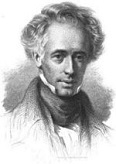
In 1828 Scottish lawyer George Combe (1788-1858), pub. the internat. bestseller (300K copies) The Constitution of Man Considered in Relation to External Objects, promoting phrenology as scientific and claiming that an understanding of phrenology leads to an understanding of human nature and a practical science of morality, getting him denounced as a materialist and atheist, which only makes him more popular?; of course he has the hair around his widow's peak fluffed-up to make his cranium appear more prominent?; "Mental qualities are determined by the size, form and constitution of the brain; and these are transmitted by hereditary descent."

In 1829 James Mill (1773-1836), father of John Stuart Mill pub. Analysis of the Phenomena of the Human Mind, which applies utilitarianism and the principle of associationism to you know what, founding modern psychology - it's going to be perfect Sundays from here on in, boys?
In 1832 Horsham, Sussex-born spiritualist English surgeon Walter Cooper Dendy (1794-1871) (known for long sessions in the reading room of the British Museum in eccentric costume) pub. On the Phenomena of Dreams and Other Transient Illusions. In 1841 he pub. The Philosophy of Mystery, about dreams, spectral illusions et al. In 1853 he pub. Psyche: A Discourse on the Birth and Pilgrimage of Thought, which coins the term "psychotherapy" (psychotherapeia); "It is clear, therefore, that thought acts on organism, like a poison or a fate." In 1861 he pub. A Gleam of the Spirit Mystery.

In 1840 German-born Am. educator (founder of Marshall College in Penn.) Frederick (Friedrich) Augustus Rauch (1806-41) pub. Psychology, or a View of the Human Soul, including Anthropology, Adapted for the Use of Colleges.


In 1840 English psychiatrist Forbes Benignus Winslow (1810-74) (descendant of Edward Winslow of Mayflower fame) pub. The Anatomy of Suicide, which claims that most suicides are victims of mental disease and not criminals. In 1843 he pub. The Plea of Insanity in Criminal Cases, followed in 1846 by The Incubation of Insanity, helping establish the plea of insanity in criminal cases. In 1847 he opens two lunatic asylums in Hammersmith, where he pioneers humane methods of treatment. In 1848 he founds the Quarterly Journal of Psychological Medicine (until 1864). In 1874 his psychiatrist son Lyttleton Stewart Forbes Winslow (1844-1913) takes over his asylums, pub. Spiritualistic Madness in 1877, which claims that spiritualism causes insanity, and stinking himself up by falsely accusing G. Wentworth Smith of Canada of being Jack the Ripper, becoming a suspect himself for a time.
In 1841 the Royal College of Psychiatrists is founded in England; the original name is Assoc. of Medical Officers of Asylums and Hospitals for the Insane, then the Medico Psychological Assoc., then in 1926 the Royal Medico Psychological Assoc., receiving its current name in 1971.
In 1844 Market Bosworth, Leicestershire-born psychiatrist Sir John Charles Bucknill (1817-97) becomes suptd. of the Devon County Asylum (until 1862), ordering that no restraints be used on patients, reforming English practice. In 1853 he founds the Journal for Mental Science (originally Asylum Journal until 1858), which in 1963 changes its name to Journal of Mental Science. In 1858 he pub. Manual of Psychological Medicine: Containing History, Nosology, Description, Statistics, Diagnosis, Pathology, and Treatment of Insanity, with an Appendix of Cases. In 1875 he travels to North Am., visiting 10 asylums in the U.S. and three in Canada, criticizing asylums who restrain patients, countering their assurance that they have to restrain them by offering 100 pounds to anyone would will visit British asylums and find them in use, causing him to be elected the first honorary member of the Assoc. of Medical Suptds. of Am. Institutions for the Insane. In 1876 he pub. Notes on Asylums for the Insane in America.

On Feb. 20, 1843 excited by the new science of psychology, Copenhagen, Denmark-born hunchback philosopher Soren (Søren) Aabye Kierkegaard (1813-55) pub. Either/Or: A Life Fragment (Enten - Eller) under the alias Victor Eremita (Victorious Hermit), about how consciousness progresses from a hedonistic aesthetic mode to a mature conscience characterized by ethical imperatives; On Oct. 16, 1843 he pub. Fear and Trembling (Begrebet Angst) under the alias Johannes de Silentio, contrasting Abraham's sacrifice of his son Isaac with Agamemnon's sacrifice of his daughter Iphigenia; title refers to Philippians 2:12 and Psalms 55:5; incl. The Knight of Faith, about the cool individual who places complete faith in himself and in God, contrasted with the knight of infinite resignation; rocks the Danish Lutheran church with its rejection of Hegelianism and anticipation of Existentialism, which dumps Idealism for the concrete reality of a "single individual"; written right after finding out that his babe Regine Olsen has said yes to his rival Johan Frederik Schlegel, causing him to turn to Lady Five Fingers with fear and trembling, while hoping that God will return her to him?; he also pub. Repetition: A Venture in Experimental Psychology; pub. under alias Constantin Constantius; the Young Man jilts his betrothed, like Kierkegaard did his babe Regine Olsen. In 1844 he pub. Philosophical Fragments pub. under the alias Johannes Climacus, about the Socratic vs. the religious methods of arriving at Truth. On June 17, 1844 he pub. The Concept of Anxiety (Dread) under the alias Vigilius Haufniensis (Watchman of Copenhagen), the first treatment of anxiety, the experience of looking over an edge and having an impulse to throw oneself over it, "the dizziness of freedom", which precedes sin as with Adam and Eve and the apple; "Consciousness presupposes itself". On Aug. 31, 1844 he pub. Four Upbuilding Discourses, about the resolution made by a single individual, leading to the leap of faith. In 1846 he pub. Concluding Unscientific Postscript to The Philosophical Fragments, a bitter attack against Hegelianism and its determinism, taking the side of free will or metaphysical libertarianism; "Subjectivity is truth". In 1849 he pub. The Sickness Unto Death under the alias Anti-Climacus, treating despair, which he equates with original sin.
In 1844 the Am. Psychiatric Assoc. (APA) is founded in Philadelphia, Penn. by 13 insane asylum and mental hospital dirs. as the Assoc. of Medical Superintendents of Am. Institutions for the Insane (AMSAII); in 1892 it becomes the Am. Medico-Psychological Assoc.; in 1921 it changes to the present name; by 2012 it has 36K members; their logo is a likeness of Benjamin Rush.
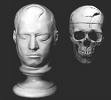
On Sept. 13, 1848 U.S. railroad worker ("Am. Crowbar Case") Phineas P. Gage (1823-60) gets a 3-ft. rod through the jaw and brain in Cavendish, Vt., which doesn't kill him, but destroys his frontal lobes and changes his personality, causing a rev. in thinking about brain functions being localizable.
In 1849 the first mental institutions in China are founded by Western missionary John G. Kerr et al.

In 1852 German philosopher Rudolf Hermann Lotze (1817-81) pub. Medizinische Psychologie oder Physiologie der Seele (Medical Psychology, or Physiology of the Soul), an attempt to straddle the two warring camps of mechanistic and non-secular explanations of psychological phenomena. In 1856-64 he pub. his magnum opus Mikrokosmus (3 vols.), arguing that natural laws of inanimate objects apply to human minds and bodies but have the function of enabling us to aim for the values set by the deity, thus making room for aesthetics.

In 1852 Vienna, Austria-born French psychiatrist Benedict Augustin Morel (1809-73) pub. Traite des Maladies Mentales (2 vols.) (1852-3); in the 2nd ed. (1860) he coins the term "dementia praecox" (demence precoce) for patients suffering from "stupor" (melancholia). In 1857 he pub. Traite des Degenerescences (Traité des Dégénérescences), promoting the Theory of Degeneration to characterize mental illnesses, which rules for the rest of the cent.

In 1855 Derby-born British sociologist Herbert Spencer (1820-1903) pub. Principles of Psychology.

In 1859 French physician Pierre Briquet (1796-1881) pub. Traite Clinique et Therapeutique de L'Hysterie, observations of 430 hysterical patients over a 10-year period; turns French neurologist Jean Martin Charcot (1825-93) onto the subject, causing him to examine patients at the Saltpetriere Hospital in Paris in the 1870s-1880s.


The Book That Shook the World? Big year for Bible skeptics, secularists, atheistic scientists, anybody against the ancien regime, as Jehovah, the Source of Life Breathed Into Mud is challenged by Evolution, Mud Coming to Life by Itself After It Bubbles Long Enough? The biggest V for the Devil since Eden? The new 95 Theses, but Darwin is smart enough not to publish it on Halloween? On Nov. 24, 1859 (Thur.) English naturalist Charles Robert Darwin (1809-82) pub. On the Origin of Species By Means of Natural Selection, Or, The Preservation of Favoured Races in the Struggle for Life; the 1st ed. sells out in 1 day; the 1872 6th ed. shortens the title to "The Origin of Species"; the decider, which causes evolutionary "survival of the fittest" theory to triumph among the intelligentsia; English Anglican minister and Cambridge U. prof. of modern history Charles Kingsley (1819-75), who received an advance copy on Nov. 18 writes that he had "long since, from watching the crossing of domesticated animals and plants, learnt to disbelieve the dogma of the permanence of the species", which Darwin adds to the next ed. of his book in a modified form: "He had gradually learned to see that it is just as noble a conception of the Deity to believe that He created a few original forms capable of self-development into other and needful forms, as to believe that He required a fresh act of creation to supply the voids caused by the action of His laws"; Darwin pub. it after spending eight years dissecting barnacles in his basement, then inexplicably switching to the Galapagos finch?; catches on first in Germany among atheists?; "If it could be demonstrated that any complex organ existed, which could not possibly have been formed by numerous, successive, slight modifications, my theory would absolutely break down"; Louis Agassiz of the U.S. opposes Darwin, preferring a theory of "Epochs of Creation", based on the absence of missing links between layers of well-formed fossil ecosystems; the phrase "I'll be a monkey's uncle" is coined by Darwin skeptics; "There is a grandeur in this view of life that, whilst this planet has gone cycling on according to the fixed law of gravity, from so simple a beginning endless forms most beautiful and most wonderful have been, and are being, evolved"; what was that about "my theory would absolutely break down" if anything is found that can't be explained by "numerous, successive, slight modifications"?; in practice Darwinism becomes a religion which denies that there is intelligent design in Nature, and therefore tries to deconstruct any evidence of it they find as they go along, yet clings to the notion of common descent, almost as if there was some original, er, accident, and ends up turning into a narrow naturalistic dogma by the end of the 20th cent., taking over U.S. and other Western educational systems with a chilling priesthood? In 1860 after failing to fit it into his Theory of Evolution, Darwin writes the immortal soundbyte: "The sight of a feather in a peacock's tail makes me sick." On Feb. 1, 1871 he writes a Letter to Sir Joseph Dalton Hooker, with the soundbyte: "It is often said that all the conditions for the first production of a living organism are now present, which could ever have been present. But if (and oh! what a big if!) we could conceive in some warm little pond, with all sorts of ammonia and phosphoric salts, light, heat, electricity, &c., present, that a protein compound was chemically formed ready to undergo still more complex changes, at the present day such matter would be instantly absorbed, which would not have been the case before living creatures were found." In 1871 he pub. The Descent of Man; "The Simidae then branched off into two great stems, the New World and the Old World monkeys; and from the latter at a remote period, Man, the wonder and glory of the universe, proceeded"; "We civilized men... do our utmost to check the process of elimination; we build asylums for the imbecile, the maimed, and the sick; we institute poor laws; and our medical men exert their utmost skill to save the life of everyone to the last moment... Thus the weak members of civilized societies propagate their kind. No one who has attended to the breeding of domestic animals will doubt that this must be highly injurious to the race of man. It is surprising how soon a want of care, or care wrongly directed, leads to the degeneration of a domestic race; but excepting in the case of man himself, hardly anyone is so ignorant as to allow his worst animals to breed"; "This is the book that contains the foundation in natural history for our view" (Marx to Engels); this book is later used by Eugenicists to justify euthanasia of misfits.

In 1860 German psychologist Gustav Theodor Fechner (1801-87) announces Elements of Psychophysics, which founds modern experimental psychology (psychophysics), and announces Fechner's Law, that the intensity of sensation varies arithmetically with an exponential variation of the arousing stimulus.

In the 1860s Dutch opthalmologist Franciscus Cornelis Donders (1818-89) first uses human reaction time to infer differences in cognitive processing.

In 1861 French neurologist Pierre Paul Broca (1824-80) discovers Broca's Area in the brain, the first to be connected with a specific function, the faculty of speech.

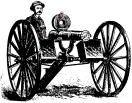
In 1861-5 the horrific U.S. Civil War sees the invention of the first modern weapon when N.C.-born agricultural equipment maker Richard Jordan Gatling (1818-1903) patents the 10-barrel hand-cranked hundreds-of-rounds-per-min. Gatling Gun (the first practical machine gun) just in time for use on some Johnny Rebs; it is first used by the Union Army in 1864, but luckily never sees extensive use.
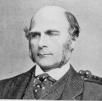
In 1869 Charles Darwin's English polymath half-cousin Sir Francis Galton (1822-1911) pub. Hereditary Genius, which attempts to prove IQ heritability, and advocates Eugenics - incl. himself among the hereditary geniuses? He goes on to found Psychometrics, Differential Psychology, and the Lexical (Sedimentation) Hypothesis of Personality.

In 1869 German philosopher Karl Robert Eduard von Hartmann (1842-1906) pub. his first book The Philosophy of the Unconscious, which becomes a hit because of its kinky title; Carl Jung later becomes a fan.
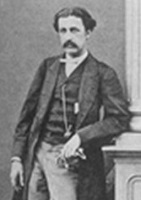
In 1872 English biologist Douglas Alexander Spalding (1841-77) pub. his discovery of Psychological Imprinting in small animals; too bad, it takes decades for his work to be recognized.

In 1874 German psychologist Wilhelm Maximilian Wundt (1832-1920) pub. Principles of Physiological Psychology, the first textbook on psychology. In 1879 he sets up the first experimental psychology lab at the U. of Leipzig, attracting students from all over the world - get your haircut and Skinner Box right here?
In 1876 Fla. State Hospital for the Insane (FSH) is founded in Chattahoochee, Fla., becoming Fla.'s first state mental inst.; on Dec. 26, 1975 the U.S. Supreme (Burger) Court rules unanimously in O'Connor vs. Donaldson that a state cannot constitutionally confine a non-dangerous individual capable of living outside this Fla. nuthouse, sparking a deinstitutionalization movement resulting in the close of many public mental institutions in the U.S.
In 1878 the English journal Brain is founded by Sir John Charles Bucknill et al.

In 1878 Ashfield, Mass.-born Williams College grad Granville Stanley Hall (1844-1924) receives the first Ph.D in a psychological subject from Harvard U. (in philosophy); in 1883 he opens the first experimental psychology research lab in the U.S. at John Hopkins U.; in 1887 he founds the Am. Journal of Psychology, and in 1892 becomes pres. #1 of the new Am. Psychological Assoc. (APA), founded at Clark U. in Worcester, Mass. in July by 26 men with a $500 contribution by Robert Pearsall Smith of the Am. Society for Psychical Research, becoming the largest prof. org. of psychologists in the U.S. and Canada, with 137K members by 2012.







Scientists turn into intellectual whores when they visit mediums in an emotion-charged search for proof of the triple-axel-pyramidal trick of life after death? In 1882 now that the stage has been set by the demise of organized religion and the rise of organized science, Utilitarian philosopher Henry Sidgwick (1838-1901), glib classicist Frederic William Henry Myers (1843-1901) (coiner of the term "telepathy") et al. found the Society for Psychical Research in London England, giving a second chance for the boys who decided to get out of show business; Mark Twain (1835-1910), who had a recurring dream about his brother's death for 25 years joins; Darwin's co-author Alfred Russel Wallace gets interested in spiritualism as a way to put a moral force into godless evolution and has a seance given by Scottish-born Conn. spiritual celeb Daniel Dunglas Home (1833-86), which shakes him up, although Robert Browning mocks him in his 1864 poem Mr. Sludge, the Medium; Boston housewife Leonora Piper (1857-1950) becomes a superstar medium, convincing Am. psychologist William James, British physicist Sir Oliver Lodge, and Australian psychical researcher Richard Hodgson (1855-1905), who spies on her during a 1888 blizzard in an attempt to expose her as a fraud, but is won over by a spiritual visit of a deceased friend; in 1900 Frederic Myers is convinced by new British medium Rosina Thompson (1868-?), who brings up the spirit of his dead lover Annie, embarrassing his wife, then accurately predicts his death within a year - first godless evolution, then a feeling of emptiness, and back to the old pagan demons, all within 30 years?

In 1883 German psychiatrist Emil Kraepelin (1856-1926) pub. Compendium der Psychiatrie, which argues that psychiatry is a branch of medical science and should be investigated by observation and experimentation like other natural sciences, calling for research into the physical causes of mental illness, and founding the modern classification system for mental disorders; he proposes that by studying case histories and identifying specific disorders the progression of mental illness can be predicted after taking into account individual differences in personality and patient age at disease onset. In 1893 he founds modern psychiatry with the clinical approach based on syndromes (patterns of symptoms), classifying psychosis into manic depression and dementia praecox ("sub-acute development of a peculiar simple condition of mental weakness occurring at a youthful age"), becoming the "Founder of Modern Psychiatry and Psychopharmacology" - so that's why psychiatry is full of krap?

In 1884 Russian physiologist Ivan Petrovich Pavlov (1849-1936) begins studying the digestive secretion of animals; in 1901 he develops the concept of the conditioned reflex using his salivating dogs. In 1927 he pub. Conditioned Reflexes: An Investigation of the Physiological Activity of the Cerebral Cortex, explaining his theory of Classical Conditioning.



In 1884 French neurologist Georges Albert Edouard Brutus Gilles de la Tourette (1857-1904) first medically describes g-d-d-mned-f-ck-in-g (coprolalia) (shit-speaking) (tic malady) Tourette's Syndrome; actually it is called Brissaud's Disease for French physician Edouard Brissaud (1852-1909) after he pub. a description in 1896, but later "Father of Modern Neurology" Jean Martin Charcot (1825-93) restores credit to Tourette - it would have to be Brutus?

In 1885 Barmen, Germany-born Hermann Ebbinghaus (1850-1909) pub. Uber das Gedachtnis (Über das Gedächtnis) (On Memory), based on self-experimentation, first describing the Learning Curve, Forgetting Curve, and Spacing Effect.

In 1886 Burlington, Vt.-born psychologist John Dewey (1859-1952) pub. Psychology, the first Am. textbook on the subject, founding Functional Psychology (Functionalism), rival to Structuralism. In 1896 he pub. the paper The Reflex Arc Concept in Psychology, treating the stimulus separate from the response, and considering the sensory stimulus, the central connection, and the motor response as working together, founding Social Behaviorism.


In 1886 Baron Richard von Krafft-Ebing (1840-1902) pub. Psychopathia Sexualis: Eine Klinisch-Forensische Studie (Sexual Psychopathy: A Clinical-Forensic Study), the largest-yet collection of case histories of sexual abnormalities and perversions, becoming a besteller going into several eds., despite his attempt to use big words to make it readable only by doctors; coins the term "masochism" for Austrian novelist Leopold Ritter von Sacher-Masoch (1836-95).

In 1886 Brno, Moravia-born physicist-philosopher Ernst Mach (1838-1916) pub. Contributions to the Analysis of Sensations (Beiträge zur Analyse der Empfindungen), formulating the concepts of Gestalt and Figural Moment.

In 1887 Painesville, Ohio-born George Trumbull Ladd (1842-1921) pub. Elements of Physiological Psychology, the first Am. textbook with substantial info. on experimental psychology.

In 1889 Union City, Mich.-born psychiatrist Henry Mills Hurd (1843-1927) becomes the first dir. of the John Hopkins Hospital, becoming its first prof. of psychiatry in 1893-1905, helping it become #1 in the U.S. In 1916 he pub. Institutional Care of the Insane in the United States and Canada (4 vols.), a history of U.S. psychiatry.



In 1890 Swiss psychiatrist Johann Gottlieb Burckhardt (1836-1907) performs the first lobotomy (frontal lobe removal) operations; too bad, one patient dies after the operation, another is found dead in a river 10 days later, and the rest exhibit altered behavior. In 1935 Portuguese neurologist Antonio Egas Moniz (1874-1955) performs the first prefrontal leucotomy by drilling holes in the patient's head and injecting alcohol to destroy the tissue, later using a leucotome (retractable wire loop) - so alcoholics are just trying to give themselves leucotomies? In 1936 Am. neurosurgeon James W. Watts (1904-94) performs his first frontal lobotomy. The Uline Ice Co. presents Doctor Egomaniac AKA Doctor Eager Money? In 1949 after U.S. doctors Walter Freeman and James W. Watts adopt the technique of Egas Moniz, who claimed a 30% success rate and became the country's first (only) Nobel Prize in Medicine winner for his barbaric "apple corer" (later ice pick) technique for prefrontal lobotomies, the first-ever U.S. lobotomy is performed on Rosemary (Rose Marie) Kennedy (1918-2005), daughter of Joseph P. Kennedy and Rose Kennedy, which leaves her childlike and in need of institutionalization; by 1951 18K+ lobotomies are performed in the U.S. alone; they are not discontinued in favor of drug treatment until the 1960s.

In 1890 Vienna, Austria-born philosopher Christian von Ehrenfels (1859-1932) pub. On the Qualities of Form (Uber Gestaltqualitäten), founding Gestalt Psychology, the theory that the mind sees the entirety before dividing it into parts, with the motto "The whole is greater (other than) the sum of the parts"; "In the case of all things that have several parts and in which the whole is not like a heap, but is a particular something besides the parts, there must be some such uniting factor."

On Sept. 25, 1890 after becoming the first to teach psychology courses in the U.S. at Harvard U. in 1875-6, New York City-born psychologist-philosopher-physician William James (1842-1910) pub. the hit textbook The Principles of Psychology, which proposes that psychology concern itself with emotions, habits, consciousness, self, adaptation, and learning, dissing Wilhelm Friedrich Hegel's metaphysical idealism, Jeremy Bentham's associationism, Herbert Spencer's materialism, and Immanuel Kant's innatism, describing the human mind as inherently purposive and selective; a novel on psychology?; "A loathsome, distended, tumefied, bloated, dropsical mass, testifying to nothing but two facts: 1st, that there is no such thing as a science of psychology, and 2nd, that W. J. is an incapable." (William James)

In 1891 Finnish sociologist Edvard Alexander Westermack (1863-1939) pub. The History of Human Marriage (2 vols.), describing the Westermarck Effect, where people who live in close domestic proximity early in life later become desensitized to close sexual attraction, adding to theories of incest taboo.





In 1892 the Berlin Laboratory (School) of Experimental Psychology is founded at the U. of Berlin by Hermann Lotze's and Franz Brentano's student Carl Stumpf (1848-1936), with students incl. Max Wertheimer (1880-1943), Kurt Koffka (1886-1941), Wolfgang Kohler (Köhler) (1887-1967), and Kurt Zadek Lewin (1890-1947). In 1922 Kohler takes over, turning it into a school for Gestalt Psychology. In 1911 Stumpf pub. The Origins of Music, founding Comparative Musicology (Ethnomusicology). In 1917 Kohler pub. The Mentality of Apes, which concludes that chimpanzees solve problems via insight not mere trial and error.


In 1894 Easton, Penn.-born James McKeen Cattell (1860-1944) and Columbia, S.C.-born James Mark Baldwin (1861-1934) found the Psychological Review to compete with the Am. Journal of Psychology (1887); Cattell goes on to make psychology into a respectable academic discipline, the NYT calling him "the Dean of American Science"; too bad, his opposition to U.S. involvement in WWII gets him fired from Columbia U., causing U.S. univs. to establish tenure.
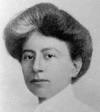
In 1894 after Columbia U. won't admit her, New York City-born Margaret Floy Washburn (1871-1939) (student of James McKeen Cattell and Edward B. Titchener) becomes the first woman to be granted a Ph.D. in psychology (at Cornell U.).




In 1895 Austrian physician Josef Breuer (1842-1925) and Freiberg, Moravia-born Austrian Jewish neurologist Sigmund Freud (1856-1939) pub. Studies on Hysteria, case studies of hysterical patient Anna O. (Bertha Pappenheim) (1859-1936), developing the Talking Cure. In 1896 Freud coins the term "psychoanalysis", splitting with Breuer over Freud's obsession with sex. On Nov. 4, 1899 Freud pub. The Interpretation of Dreams (Die Traumdeutung), claiming that he's discovered hidden layers of primitive sexual and aggressive forces that must be controlled to prevent societies from collapsing into chaos and destruction, founding Psychoanalysis, which focuses on the all-powerful Oedipus (Oedipal) Complex, which he claims Shakespeare's Hamlet suffers from; he gets a whopping $200 for it - not enough porno in it to pay more? In 1901 Freud pub. The Psychopathology of Everyday Life; "When a member of my family complains that he or she has bitten his tongue... instead of the expected sympathy I put the question, 'Why did you do that?'" In 1908 he pub. the paper On the Sexual Theories of Children, introducing the concept of Penis Envy. In 1908 he also pub. the paper 'Civilized' Sexual Morality and Modern Nervous Illness. In 1913 he pub. Totem and Taboo: Resemblences Between the Mental Lives of Savages and Neurotics. In 1914 he pub. On Narcissism: An Introduction. In 1917 he pub. Introduction to Psychoanalysis, and Mourning and Melancholia. In 1921 he pub. Group Psychology and the Analysis of the Ego, containing the soundbyte: "Libido is an expression taken from the theory of the emotions", claiming that all neuroses are caused by emotion, and are unpleasurable, hence the cure is to analyze, work through, and uproot all emotions "like the draining of the Zuyder Zee", with the psychoanalyst helping make the unconscious conscious by providing the patient with cognitive insight, subduing the drive of the irrational Id to emerge. In 1923 he pub. The Ego and the Id (Das Ich und das Es). In 1937 he pub. Analysis Terminable and Interminable; "Experience has taught us that psycho-analytic therapy - the liberation of a human being from his neurotic symptoms, inhibitions and abnormalities of characters - is a lengthy business"; "Analysis... seems to be the third of those 'impossible professions'... The other two... are the bringing up of children and the government of nations." In 1956-74 the English Standard Ed. of the Complete Psychological Works of Sigmund Freud is pub. in 24 vols. Freud calls Bremen, Germany-born Karl Abraham (1877-1925) his "best pupil"; too bad the good die young?
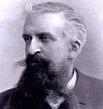
In 1895 French psychologist-sociologist Gustave Le Bon (1841-1931) pub. The Crowd: A Study of the Popular Mind (La Psychologie des Foules), which becomes the Bible of Fascist leaders Adolf Hitler and Benito Mussolini, and is used by Sigmund Freud's nephew Edward Bernays to create mass media manipulation and propaganda.

In 1896 Chichester, England-born Wilhelm Wundt student Edward Bradford Tichener (1867-1927) pub. An Outline of Psychology, founding Structuralism, and coining the term along with Functionalism.

In 1896 Philly-born psychologist Lightner Witmer (1867-1956) opens the world's first psychological clinic at the U. of Penn., founding Clinical Psychology and coining the term.

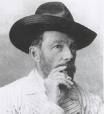
Can you grasp this? In 1897 English sexologist Havelock Ellis (1859-1939), who is impotent until he discovers urolagnia at age 60, and is still a virgin at age 32 when he marries lesbian writer Edith Mary Oldham Lees (1891-1916) in Nov. 1891, then goes back to his bachelor life in Paddington with an open marriage, and English gay poet John Addington Symonds (1840-93) pub. Studies in the Psychology of Sex: Sexual Inversion (vol. 2 of 6) (1897-1910), the first English medical textbook on homosexuality ("a barbarously hybrid word... I claim no responsibility for it"), which Ellis approves of, and denies is immoral, a disease or a crime; 7 of the 20 examples are of man-boy love; after a celebrated obscenity trial it is banned in England as a "wicked, bawdy, scandalous, and obscene book", causing a U.S. publisher to pub. it, changing it from vol. 1 to vol. 2 of the series; it is limited to medical profs. until 1935; the 3rd ed. (1915) talks about the "great prevalence of sexual inversion in American cities", and how the fellatio-seeking "fairies" wear red ties as their badge - like Ronald Reagan?

In 1898 German psychiatrist Sigbert Josef Maria Ganser (1853-1931) first describes drip-drip-drip Ganser Syndrome AKA Nonsense Syndrome, Balderdash Syndrome, Syndrome of Approximate Answers, (Hysterical) Pseudodementia, and Prison Psychosis.


In 1898 Ukrainian-born Am. psychiatrist Boris Sidis (1867-1923) (student of William James) pub. The Psychology of Suggestion: A Research into the Subconscious Nature of Man and Society. In 1914 after opening the Sidis Psychotherapeutic Inst. in Portsmouth, N.H. in 1910 he pub. The Foundations of Normal and Abnormal Psychology, attempting to give psychology a scientific basis, expounding his theory of Moment Consciousness. In 1922 he pub. Nervous Ills: Their Cause and Cure, blaming fear as the underlying cause of much mental illness. Too bad, he goes to work on his son William James Sidis (1898-1944), trying to turn him into the world's greatest genius (WGG), which only burns him out young, his life ending in a fizzle.

In 1898 Williamsburg, Mass.-born psychologist Edward Lee "Ted" Thorndike (1874-1949), student of James McKeen Catrell at Columbia U. pub. his dissertation "Animal Intelligence: An Experimental Study of the Associative Processes in Animals", pioneering animal psychology experiments, and concluding that they learn by trial and error not insight, but at different speeds, which he calls Connectionism. During WWI he created the early alpha and beta versions of the 1968 U.S. Army Armed Services Vocational Aptitude Battery (ASVAB) enlistment qualification test. In 1920 he pub. the article A Constant Error in Psychological Ratings, describing the Halo Effect, when someone's shine colors your opinion of them. In 1921 he pub. The Teacher's Word Book to help them with reading instruction; 2nd ed. 1932; 3rd ed. 1944. In 1922 he pub. The Psychology of Arithmetic, followed by The Measurement of Intelligence (1927), Human Learning (1931), claiming that the ability to learn doesn't decline until age 35, after which it declines at the rate of 1% per year, and The Psychology of Wants, Interests and Attitudes (1935).

In 1900 Russian neurologist Vladimir Mikhailovich Bekhtereve (Bechterev) (1857-1927) discovers the role the hippocampus plays in memory.

In 1901 Bavarian-born German psychiatrist Alois Alzheimer (1864-1915) of Frankfurt discovers Alzheimer's Disease after patient Auguste Deter (1850-1906) tells him "I have lost myself" - old timer's disease?


In 1902 Sigmund Freud founds the Wednesday (Vienna) Psychological Society, which meets at his home and launches the psychoanalytic movement, with members incl. Vienna-born Alfred Adler (1870-1937) (pres. #1), who breaks with him in 1911, founding Individual Psychology, and coining the term Inferiority Complex, and Swiss-born Paul Eugen Bleuler (1857-1939), who also breaks with him in 1911, coining the terms "autism", "ambivalence", and "schizophrenia", which he believes is not incurable, necessitating early discharge from the hospital to avoid institutionalization. Alfred Adler leaves the soundbyte: "There is a Law that man should love his neighbor as himself. In a few hundred years it should be as natural to mankind as breathing or the upright gait."

In 1902 Zurich, Switzerland-born Am. psychiatrist Adolf Meyer (1866-1950) becomes dir. of the Pathological (later Psychiatric) Inst. of the N.Y. state hospital system, going on to influence U.S. psychiatry via his "common sense" approach of keeping detailed patient records and by introducing the classification system of Emil Kraepelin and the sexual ideas of Sigmund Freud; in 1906 he calls dementia praecox a "reaction type", a "discordant bundle of maladaptive habits that arose as a response to biopsychosocial stressors"; in 1908 after coining the term "mental hygiene", he helps found the Conn. Society for Mental Hygiene, followed in 1909 by the Nat. Committee for Mental Hygiene.

In 1902-3 French social psychologist
Gabriel Tarde (Jean-Gabriel De Tarde)
(1843-1904) pub.
La Psychologie Economique
(2 vols.), founding Economic Psychology.

In 1903 French psychologist Pierre Marie Felix Janet (1859-1947) pub. Obsessions and Psychasthenia, developing a grand model of the mind in terms of levels of energy, efficiency, and social competence, and defining the Obsessive-Compulsive Disorder (OCD). He follows it with La Medecine Psychologique (1923), and From Anguish to Ecstasy (1926), defining the Nine Tendencies of increasingly complex org. levels, incl. the the Four Lower Tendencies (incl. Reflexive, Elementary Intellectual), the Two Middle Tendencies (Language, Social Sorld), and the Three Higher Tendencies (Rational-Ergotic World of Work, Experimental, Progressive). Neurosis is thus a failure to integrate, causing a regression to earlier tendencies, and subconscousness is "an act which has kept an inferior form amidst acts of a higher level." He coins the terms Dissociation and Subconscious.

In 1903 Englewood, Ill.-born psychologist Helen Thompson Woolley (1874-1947) pub. The Mental Traits of Sex: An Experimental Investigation of the Normal Mind in Men and Women, the first dissertation on psychological sex differences, finding that men performed better on most tests of motor ability, while women tended to do better on some of the coordination tasks; men showed more creativity, while women showed more acute senses and better memory performance; she found no evidence that women are influenced by emotion more in life than men, and in general found more similarities than differences.



Just upload your catchphrases at Moron.com? In 1905 the Binet-Simon IQ Test is developed by French psychologists Alfred Binet (1857-1911) and Theodore Simon (1873-1961); too bad, to take it you have to speak French, but never fear, in 1908 East Vassalboro, Maine-born God's-gift psychologist Henry Herbert Goddard (1866-1957), dir. (1906-8) of the Vineland Training School for Feeble-Minded Girls and Boys in Vineland, N.J. trans. it into English and distributes 22K copies, introducing the term "mormon", er, "moron" and promoting not only intelligence testing to weed them out, but proposing IQ labels on May 18, 1910 (moron is actually the top of the food chain, with IQ of 51-70, i.e., mental age of 8-12, followed by imbecile at 26-50 and oh no, dumber-than-a-donut idiot at 0-25), then helping write the first U.S. law is founded requiring special segregated education for them in public schools along with the blind and deaf; in 1912 he pub. The Kallikak Family: A Study in the Heredity of Feeble-Mindedness; now listen while I tell you a story about a man named Martin, whose Appalachian descendants get into inbreeding and become "a race of defective degenerates", causing him to call for eugenics programs incl. compulsory sterilization and segregation for the feeble-minded; in 1913 he tests IQs of 172 Euro immigrants on Ellis Island, finding that he correctly matches 80% of feeble-minded immigrants with those classed that way before they left; in 1914 he becomes the first U.S. non-moron psychologist to lend his high IQ to testify in court that being a moron should limit criminal responsibility of defendants; he also utters the unmoronly soundbyte: "Democracy means that the people rule by selecting the wisest, most intelligent and most human to tell them what to do to be happy" - what, me worry, here comes another "There are two kinds of people" messiah - not, since now morons ain't even human (you need a toupee with some brains in it, nyuk nyuk?)

In 1905 Williamsburg, Mass.-born psychologist Edward Lee "Ted" Thorndike (1874-1949) of Columbia U. pub. the Law of Effect: "Responses that produce a satisfying effect in a particular situation become more likely to occur again in that situation, and responses that produce a discomforting effect become less likely to occur again in that situation."

In 1907 Austrian-born Am. psychiatrist Abraham Arden Brill (1874-1948) performs tests with Carl Jung at the Zurich Psychiatric Clinic which corroborate the theories of Sigmund Freud, who is also of Zurich; next year Brill returns to the U.S., becoming the first to introduce Freudian psychoanalysis to the U.S. and trans. Freud into English.

In 1907 Wiesbaden-Biebrich-born German historian-psychologist-sociologist-philosopher Wilhelm Dilthey (1833-1911) (who holds Hegel's chair in philosophy at the U. of Berlin) pub. The Essence of Philosophy (Das Wesen der Philosophie), which expounds his Romantic hermeneutics that considers understanding as the key for the human sciences (human expression of life) in contrast with the natural sciences (Nature), influencing Existentialism and making fans of Martin Buber and Martin Heidegger; he attempts to define philosophy through history with the three basic Weltanschauungs (popularizing the term), incl. Naturalism, which sees man as determined by Nature, Subjective Idealism, in which man is conscious of his separation from Nature by his freewill, and Objective Idealism, in which man is conscious of his harmony with Nature, picturing a spectacle of philosophies passing through history, rising and falling, and covering the Earth like vegetation, causing the philosopher to have to classify them "as the botanist classifies plants"; as a balance, the "formative laws of the mind" and the "structure of inner life" AKA structure psychology and the "ever constant structure of life", i.e. psychology is expected to provide a firm foundation for all human studies one day.

In 1908 Danzig, Germany-born psychologist (in the U.S.) Hugo Munsterberg (Münsterberg) (1863-1916) pub. On the Witness Stand: Essays on Psychology and Crime, which pioneers jury research; "The lawyer alone is obdurate. The lawyer and the judge and the juryman are sure that they do not need the experimental psychologist... They go on thinking that their legal instinct and their common sense supplies them with all that is needed and somewhat more... Just in the line of the law it therefore seems necessary not to rely simply on the technical statements of scholarly treatises, but to carry the discussion in the most popular form possible before the wider tribunal of the general reader." In 1913 he pub. Psychology and Industrial Efficiency, written with the goal "to sketch the outlines of a new science which is to intermediate between the modern laboratory psychology and the problems of economics: the psychological experiment is systematically to be placed at the service of commerce and industry", founding Industrial and Organizational Psychology.

In 1908-9 Gloucestershire, England-born surgeon Wilfred Batten Lewis Trotter (1872-1939) pub. Herd Instinct and Its Bearing on the Psychology of Civilized Man, explaining the Herd Instinct. In 1916 after having the ideal example, he pub. Instincts of the Herd in Peace and War.

In Sept. 1909 after uttering the soundbyte "They don't realize that we are bringing them the plague" on arrival in the George Washington in New York City, Sigmund Freud visits Clark U. in Worcester, Mass., delivering a series of lectures on sex, dreams, and the human mind, giving him his first public recognition, selling Am. psychiatrists on his theories; too bad, he develops a strange grudge against Americans, later calling them "savages", and never returns - get a life?


In 1910 Oldenburg, Germany-born psychiatrist Karl Theodor Jaspers (1883-1969) pub. a paper on paranoia which introduces the biographical method of study of patients. In 1913 he pub. Gen. Psychopathology (Allgemeine Psychopathologie) (2 vols.), which becomes a classic, setting the model for modern diagnostic criteria; he states that many symptoms of mental illness, esp. delusions are "un-understandable", probably a sign of an underlying primary disorder. He and Kurt Schneider (1887-1967) go on to found the Heidelberg School of Psychiatry.

In 1910 Michigan City, Ind.-born psychologist Grace Helen Kent (1875-1973) pub. the Kent-Rosanoff Free Association Test, one of the first with objective scoring and norms; male colleague J. Rosanoff is just along for the ride?
In 1910 the Internat. Psychoanalytical Assoc. (IPA) is founded by Sigmund Freud, with Carl Jung as pres. #1, and Otto Rank as secy. #1; in 1911 the Am. Psychoanalytic Assoc. (APsaA) is founded.

In 1911 English psychologist William McDougall (1871-1938), founder of Hormic (Gr. "horme" = impulse) Psychology, which claims that behavior is goal-oriented and purposive pub. Body and Mind: A History and Defence of Animism, which claims that all matter has a mental aspect and that the mind (which is distinct from the brain) guides evolution; he also claims that telepathy has been scientifically proven, becoming pres. of the Society for Psychical Research in 1920, and the Am. Society for Psychical Research in 1921, helping J.B. Rhine establish the Parapsychology Laboratory at Duke U. in 1927.


In 1912 Sigmund Freud's Kesswil, Thurgau, Switzerland-born student Carl Gustav Jung (1875-1961) pub. Psychology of the Unconscious (Wandlungen und Symbole der Libido), going on to coin the term Collective Unconscious, with the soundbyte: "My thesis then, is as follows: in addition to our immediate consciousness, which is of a thoroughly personal nature and which we believe to be the only empirical psyche (even if we tack on the personal unconscious as an appendix), there exists a second psychic system of a collective, universal, and impersonal nature which is identical in all individuals. This collective unconscious does not develop individually but is inherited. It consists of pre-existent forms, the archetypes, which can only become conscious secondarily and which give definite form to certain psychic contents." In Sept. 1913 he meets for the last time with his mentor in Munich, after which they split and go their separate ways, with Jung citing Freud's refusal to acknowledge religion and spirituality, going on to found Analytical (Jungian) Psychology; Jung allegedly has a vision of a "monstrous flood" engulfing Europe, a prediction of WWI. In 1916 he pub. Seven Sermons to the Dead, ascribed to 2nd cent. Gnostic teacher Basilides; it talks about the Pleroma, the Abraxas, the soul, and the principle of Individuation, warning that the mystical tendency to unite with God is a dangerous psychological desire to identify with the unconscious; "This is one of the great difficulties in experiencing the unconscious, that one identifies with it and becomes a fool." He leaves the weird red-covered medieval tome Red Book (Liver Novus) (Lat. "New Book), written in 1914-30, detailing his fight with his own demons, which is locked in a bank vault and not pub. until 2009. During his Red Book period he developed the theory of archetypes, collective unconscious, and the process of individuation.

In 1912 Prague-born psychologist Max Wertheimer (1880-1943) pub. Experimental Studies of the Perception of Movement, helping found Gestalt Psychology.

On Oct. 30, 1913 the British Psycho-Analytical Society in London, England is founded by psychiatrist Albert Ernest Jones (1879-1958), who becomes Sigmund Freud's official biographer.

In 1913 Bucharest-born psychiatrist Jacob Levy Moreno (Iacob Levy) (1889-1974) pioneers Group Psychotherapy (Therapy) in Vienna, which evolves into Psychodrama and Sociometry. In 1921 he conducts the first large scale public Psychodrama session in the Komedienhaus in Vienna, moving to New York City in 1925. He later tells about a 1912 encounter with Freud: "I attended one of Freud's lectures. He had just finished an analysis of a telepathic dream. As the students filed out, he singled me out from the crowd and asked me what I was doing. I responded, 'Well, Dr. Freud, I start where you leave off. You meet people in the artificial setting of your office. I meet them on the street and in their homes, in their natural surroundings. You analyze their dreams. I give them the courage to dream again. You analyze and tear them apart. I let them act out their conflicting roles and help them to put the parts back together again.'"

In 1913 S.C.-born psychologist John Broadus Watson (1878-1958) (first psychology Ph.D granted by the U. of Chicago) gives the address Psychology as the Behaviorist Views it at Columbia U., causing a rev., and coining the word "Behaviorism", the rejection of the concept of mind and consciousness - no wonder it's like a party in here? In 1920 Watson and his asst. Rosalie Rayner perform the Little Albert Experiment, which uses classical conditioning to make a young boy afraid of white rats.


On Aug. 4, 1914 - Nov. 11, 1918 the horrific World War I causes 15M deaths and 39M military casualties. and destroys the Old Order of white formerly Christian Europe. On Feb. 26-28, 1915 the Germans first use a Flamethrower (Flame Projector) in the village of Douaumont, France near Verdun, becoming the first of 653 flamethrower attacks in the war. On Apr. 1, 1915 French aviator Roland Garros (1888-1918) becomes the first pilot to shoot down an aircraft using a deflector gear, which allows shooting through the propeller; after more Vs against German aircraft on Apr. 15 and Apr. 18, he is shot down and the Germans capture his plane, after which Dutch designer Anthony (Anton Herman Gerard) Fokker (1890-1939) clones then improves the deflector gear into the synchronization (interrupter) gear, mounting them on the new Fokker E.I. in Aug., beginning the Fokker Scourge as they shoot down nearly every enemy aircraft they encounter and generate the first German aces, incl. Max Immelmann; next year the French counter with the Nieuport 11 Bebe (Bébé), in which the gun is mounted on the top wing clear of the prop, and the British with the F.E.2b and D.H.2 (Feb. 1916), which mount the engine backwards with the prop in back, causing them to be called "pushers", ending the Fokker Scourge by spring 1917. In 1915 arsenic-based vomiting-sneeze gas Adamsite (DM) (diphenylaminechlorarsine) is synthesized by Heinrich Otto Wieland (1877-1958) of Germany; in 1918 Roger Adams of the 1918 duplicates it, and both sides stockpile it, but it is allegedly never used on the battlefield.
On Mar. 22, 1916 the British have their first success with their new Depth Charge off the SW coast of Ireland, destroying a German U-boat. Are you used to Hell yet, try this? On Sept. 15 Winston Churchill's pet project the Tank (Russian Water Closet) (Char-Schneider) is first used by the Brits in the Somme, with 49 tanks advancing on a wide front, 10 being hit by German artillery fire, nine breaking down with mechanical difficulties, and five failing to advance; the technical leap finally causing British Gen. Haig to order 1K more, while it causes a little panic among the Germans, who counter with the Siegfried Line in N France, which the Allies call the Hindenburg Line - would its use in July have won the war for the Allies immediately? British psychiatrist Maj. Sir Frederick Walker Mott (1853-1926) pub. The Effects of High Explosives Upon the Central Nervous System in The Lancet, followed in 1919 by War Neuroses and Shell Shock, first proposing the theory of "shell shock".

In 1917 Belchertown, Mass.-born psychologist Robert Sessions Woodworth (1869-1962) creates the Woodworth Personal Data Sheet (WPDS) AKA the Woodworth Psychoneurotic Inventory (WPI) and the Woodworth Psychopathic Questionnaire (WPQ), the first personality test, designed to prevent soldier shellshock, which is ready too late for use in WWI but is used until the 1930s. In 1921 he pub. Psychology: A Study of Mental Life, which becomes a std. undergrad textbook; the 2nd ed. (1929) introduces the Stimulus-Organism-Response (S-O-R) functionalist approach, which differs from the Stimuls-Response (S-R) behaviorist approach by claiming that a stimulus elicits a different response depending on the state of the organism. In 1938 he pub. Experimental Psychology (2nd ed. in 1954).

On Feb. 26, 1920 Robert Wiene's The Cabinet of Dr. Caligari debuts, starring Werner Krauss (1884-1959) as Caligari; co-stars Conrad Veidt as his somnambulist Cesare, who are visited at the carnival in Holstenwall, Germany by Francis (Friedrich Feher), and Alan (Hans Heinrich von Twardowski), whom Caligari correctly prophesies will die by dawn, causing Francis to begin investigating them; Cesare then kidnaps Francis' babe Jane (Lil Dagover), and after Caligari orders him to kill her, he falls in love with her and helps her escape, falling to his death; meanwhile Caligari is discovered to be head of a local insane asylum, obsessed with a medieval Dr. Caligari, after which the twist ending has Caligari revealed to be the insane asylum doctor who is trying to cure the narrator Francis all along - he's got documentation, play ball?
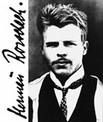

In 1920 Zurich-born Swiss psychiatrist Herman Rorschach (1884-1922), nicknamed "Kleck" (inkblot) for his interest in art invents the Rorschach Inkblot Test, based on a series of 10 inkblot plates.


In 1921 German pharmacologist Otto Loewi (1873-1961) discovers the chemical transmission of nerve impulses, later tracing it to acetylcholine after a dream on Easter Sat. night 1923, making him the "Father of Neuroscience"; English neuroscientist Sir Henry Hallett Dale (1875-1968) discovers it too, and they share the 1936 Nobel Med. Prize.

In 1922-37 German Neo-Freudian psychoanalyst Karen Horney (1885-1952) pub. Feminine Psychology (14 essays), taking on Sigmund Freud's theory of Penis Envy, founding Feminist Psychology. In 1950 she pub. Neurosis and Human Growth: The Struggle Toward Self-Realization, claiming that neuroses are the antithesis of healthy growth, and are conditioned by culture rather than instinctual drives like Freud claims.
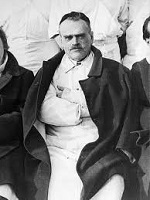
In 1923 French psychiatrist Jean Marie Joseph Capgras (1873-1950) first describes Capgras Delusion (Syndrome), where a person (usually a woman) comes to believe that a familiar person has been replaced by a double - the secret of Facebook?


In 1923 Swiss developmental psychologist Jean Piaget (1896-1980) pub. The Language and Thought of the Child, followed by The Child's Conception of the World (1925), The Moral Judgment of the Child (1932), Play, Dreams and Imitation in Childhood (1945), The Construction of Reality in the Child (1950), The Principles of Genetic Epistemology (1950), The Psychology of the Child (with Barbel (Bärbel) Inhelder (1913-97)) (1950), The Psychology of Intelligence (1951), The Origins of Intelligence in Children (1952), The Child's Conception of Number (1952), The Growth of Logical Thinking from Childhood to Adolescence (with B. Inhelder) (1958), The Early Growth of Logic in the Child (1959), The Child's Conception of Space (with B. Inhelder) (1967), Genetic Epistemology (1968), and Structuralism (1970). In 1955 he founds the Internat. Center for Genetic Epistemology in Geneva, becoming known as "the great pioneer of the constructivist theory of knowing" (Ernst von Glasersfeld).

In 1924 German neurologist Hans Berger (1873-1941) of the U. of Jena invents Electroencephalograpy (EEG), proving that the mind exhibits continuous electrical activity, casting doubt on the Pavlovian model of perception and response; in 1934 B.C.H. Matthews and Edgar Douglas Adrian verify his conclusions by tracing a single impulse in a single nerve fiber using a galvanometer.

In 1924 Harrisburg, Penn.-born psychologist Jacob Robert Kantor (1888-1984) pub. Interbehavioral Psychology (Principles of Psychology) (2 vols.), defining a new field based on a combo of John Dewey and Albert Einstein which he calls "Field-theoretic, not lineal-mechanistic, self-actional, or mediational; a system that is naturalistic, not dualistic; and a system that is comprehensive, not narrowly focused", with the formula PE = C(k, sf, rf, hi, st, md), where PE = psychological event, C = interdependence, k = specificity of each behavior segment, sf = stimulus function, rf = response function, hi = history of interactions, st = interactional setting, and md = medium of contact.

In 1924 Vienna, Austria-born psychoanalyst Otto Rank (Rosenfeld) (1884-1939), Freud's right-hand man since 1905 pub. The Trauma of Birth (Das Trauma der Geburt), coining the term "pre-Oedipal" for the "phase before the development of the Oedipus Complex", causing Freud to break with him, with Rank responding that "Surgical therapy is uprooting and isolates the individual emotionally, as it tries to deny the emotional life." In 1926 he gives the lecture "The Genesis of the Object Relation", which introduces Object Relations Theory, about how one develops a psyche as influenced by experiences during infancy. In 1929-31 he pub. Will Therapy, containing the soundbyte: "The emotional life develops from the sexual sphere, therefore his sexualization in reality means emotionalization"; the nasty Rank-Freud feud keeps psychologists from developing a theory of emotional intelligence until the end of the 20th cent.?
In 1926 the Societe Psychanalytique de Paris (Paris Psychoanalytic Society) is founded with the endorsement of Sigmund Freud; the Nazis close it in 1940.
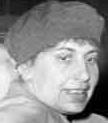
In 1927 Sigmund Freud's Vienna-born youngest daughter Anna Freud (1895-1982) pub. An Introduction to the Technique of Child Analysis, the first of 8 vols., becoming the "Founder of Child Psychoanalysis"; too bad, she remains a lifelong virgin, getting psychoanalyzed by her daddy for masturbating, later claiming that daydreaming might suppress the urge.

In 1927 Soviet pshrink Bluma Wolfovna Zeigarnik (1901-88) describes the Zeigarnik Effect, that people remember uncompleted or interrupted tasks better - the reason people hold grudges?

In 1927 Austrian psychiatrist Manfred Joshua Sakel (1900-57) develops Insulin Shock (Coma) Therapy for use on patients with schizophrenia; totally useless, the coverup falls through and it's discontinued in the 1970s.

In 1929 Philly-born experimental psychologist Edwin Garrigues "Gary" Boring (1886-1968) (student of Edward B. Titchener) pub. A History of Experimental Psychology, founding the subject of the history of psychology - his name gives the subject its rep? In 1930 he pub. a discussion of the perceptually ambiguous Boring Figure. On Dec. 6, 1941 he pub. Sensation and Perception in the History of Experimental Psychology, popularizing the term "Zeitgeist". In 1961 he pub. Psychologists at Large: An Autobiography and Selected Essays (3 vols.).

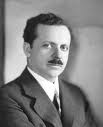
On Mar. 31, 1929 (Easter Sun.) after cigarette manufacturers hire Austrian-born Freudian psychoanalyst Abraham Arden Brill (1874-1948) to tell them how to get women to smoke cigarettes, and he tells them that it would give them their own penises, his mentor Edward Louis Bernays (1891-1995) (known for selling Calvin Coolidge to the public) hires women to join the Easter Sun. Parade in New York City and whip them out, calling them Torches of Freedom a la the Statue of Liberty, breaking the social barrier for women smokers.

In 1931 Montezuma, Ind.-born psychologist Gordon Willard Allport (1897-1967) et al. pub. the Allport-Vernon-Lindzey Study of Values, which defines six major value types: theoretical (discovery of truth), economic (what is most useful), aesthetic (form, beauty, and harmony), social (seeking love of people), political (power), and religious (unity).
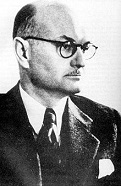
In 1932 Am. psychologist Edward Chace Tolman (1886-1959) pub. Purposive Behavior in Animals and Men, founding Purposive Behaviorism, breaking ranks with B.F. Skinner by leaving room for learned flexibility via Latent Learning.

In 1933 Hungarian psychoanalyst (colleague of Sigmund Freud) Sandor Ferenczi (1873-1933) pub. the paper "The Confusion of Tongues Between Adults and Children: The Language of Tenderness and of Passion", claiming that patient accounts of sexual abuse in childhood are truthful, caused when the adult misinterprets a child's passion tongue with his own sexual tongue, causing Freud to break with him; his collaboration with Otto Rank to create a "here and now" psychotherapy later leads Carl Rogers to develop Person-Centered Therapy.

In 1933 Russian psychiatrist Pyotr Gannushkin (1873-1933) posth. pub. Manifestations of Psychopathies: Statics, Dynamics, and Systematic Aspects, a major work defining psychopathies (personality disorders).

In 1933 Akron, N.Y.-born psychologist Clark Leonard Hull (1884-1952) pub. Hypnosis and Suggestibility: An Experimental Approach, proving that hypnosis is not sleep and founding modern hypnosis research. In 1940 he pub. Mathematico-Deductive Theory of Rote Learning, followed in 1943 by Principles of Behavior: An Introduction to Behavior Theory, which establish animal learning-conditioning study as the dominant learning theory in the West.

In 1933 Austrian Jewish psychoanalyst Wilhelm Reich (1897-1957) pub. Character Analysis, which argues that character structures are orgs. of resistance by which people avoid facing their neuroses, and are sustained biologically as body types via unconscious muscular contraction; he also pub. The Mass Psychology of Fascism, about how the rise of Fascism is a symptom of sexual repression; in 1936 he pub. Sexuality in the Culture War for the Socialist Restructuring of Humans (Die Sexualitat im Kulturkampf zur Sozialistischen Umstrukturierung des Menschen) (The Sexual Revolution), which reconstructs the Sex Rev. in the Soviet Union since 1922 and how Joseph Stalin quashed it to keep people under the er, thumb of the state, founding Vegetotheraphy, in which the patient takes off their clothing and is massaged by the therapist to shed the body's muscular armor, pissing off other psychoanalysts by violating their taboos.

In 1934 Budapest, Hungary-born psychiatrist Ladislas J. Meduna (1896-1964) discovers that Pentylenetetrazol (Metrazol), causes convulsions, causing it to be used in Convulsive Therapy until being replaced by Electroconvulsive Therapy in 1939; the FDA revokes approval in 1982.

In 1934 Russian psychologist Lev Vygotsky (1896-1934), late 1920s founder of Cultural-Historical Psychology pub. Thought and Language (Thinking and Speech), about inner vs. external (normal) speech, proposing the Zone of Proximal Development (ZPD) for a child's range of tasks.

In 1935 Chicago, Ill.-born physician Helen Flanders Dunbar (1902-59) pub. Emotions and Bodily Changes: A Survey of Literature on Psychosomatic Interrelationships, 1910-1933, founding modern research on psychosomatic illnesses. In 1939 she becomes ed. #1 of the journal Psychosomatic Medicine: Experiments and Clinical Studies. In Dec. 1942 she founds the Am. Psychosomatic Society (Am. Society for Research in Psychosomatic Problems).


In 1935 New York City-born psychologist Henry Alexander Murray (1893-1988) and his wife Christiana Drummond Morgan (nee Councilman) (1897-1967) of Harvard U. develop the Thematic Apperception Test (TAT), AKA the Picture Interpretation Technique, using a set of provocative and ambiguous pictures and requesting the subject to tell as dramatic a story as they can to explain each.

In 1935 Rock Creek, Ohio-born psychologist Theodore Mead Newcomb (1903-84) begins the Bennington College Study (ends 1939) at a conservative women's college, documenting the liberalization of their political beliefs along with the effects of proximity on acquaintance and attracion.

In 1935 Rutherford County, Tenn.-born psychologist John Ridley Stroop (1897-1973) pub. the Stroop Effect, that it takes longer to name the color of a word printed in a color other than the one denoted by the name.
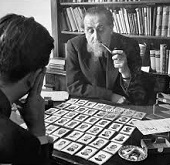
In 1935 Hungarian pshrink Leopold Szondi (1893-1986) develops the Szondi Test, based on his theory of eight drive needs, incl. h-drive (hermaphroditism), sadist drive, e-drive (epsilepsy), hysteric drive, katatonic drive, paranoid drive, depressive drive, and maniac drive; he goes on to develop Fate Psychology and Fate Analysis, becoming the 3rd alternative to Sigmund Freud and Carl Jung, focusing on the family unconscious rather than the individual or collective unconscious.

In 1936 Posen, Prussia Germany-born psychologist ("Father of Social Psychology") Kurt Zadek Lewin (1890-1947) (pr. luh-VEEN) pub. Principles of Topological Psychology, which contains Lewin's Equation B = f(P,E), meaning that behavior is a function of a person in their environment. In 1946 he pub. the paper "Action Research and Minority Problems", coining the term "Action Research" to mean "a comparative research on the conditions and effects of various forms of social action and research leading to social action" that uses "a spiral of steps, each of which is composed of a circle of planning, action, and fact-finding about the result of the action." In 1947 he coins the term "Group Dynamics". In the 1940s he proposes a Change Management Model, consisting of three stages: unfreeze, change, refreeze.

In 1936 Am. psychologist Kenneth Wartenbe Spence (1907-67) pub. the paper "The Nature of Discrimination Learning in Animals", followed in 1937 by "The Differential Response in Animals to Stimuli Varying in a Single Dimension", analyzing discrimination learning in terms of gradients of excitation and inhibition provided, showing that mathematical deductions from a quantitative theory could generate interesting and empirically testable predictions.

In 1936 Chicago, Ill.-born psychologist Louis Leon Thurstone (1887-1955) becomes pres. #1 of the Psychometric Society. In 1938 he pub. Primary Mental Abilities, which proposes factoring gen. intelligence into seven Primary Mental Abilities (PMAs) incl. verbal comprehension, word fluency, number facility, spatial visualization, associative memory, perceptual speed, and reasoning.
In 1936 the Wonderlic Personnel Test is created by Eldon F. Wonderlic of Northwestern U. to measure gen. cognitive ability in math, reasoning, and vocabulary, consisting of 50 multiple-choice questions to be answered in 12 min., with a score of 20 considered average, and a score of 10 suggesting a person is barely literate, becoming famous when given to top NFL quarterback prospects Peyton Manning and Ryan Leaf before the 1997 NFL draft, leading to the NFL Player Assessment Test in 2013.



In Apr. 1938 Italian neurologist Ugo Cerletti (1877-1963) and Italian psychiatrist Lucio Bini (1908-64) of Rome discover Electroconvulsive (Electric Shock) Therapy - Rome, home of the Inquisition? On Nov, 19, 1975 Milos Forman's One Flew Over the Cuckoo's Nest debuts, based on the 1962 Ken Kesey novel, starring Jack Nicholson as two-bit crook Randle Patrick McMurphy, who fakes insanity to get sentenced to a cushy nuthouse, and Louise Fletcher as mean, cunning head nurse Ratched, who gets in a war of wills and finally turns him into a drugged, shocked-out lobotomized mush-head, after which Big Chief Bromden (Will Simpson) smothers him with a pillow to put him out of his misery, and escapes to Canada; film debuts of Sampson, Brad Dourif (as suicidal Billy Bibbit), and Christopher Lloyd (as Jim Taber); wins five Academy Awards (most since "It Happened One Night" in 1934); Kirk Douglas is hurt when his son Michael, the producer, passes him over for Nicholson as too old, since he originated the role onstage; #3 grossing film of 1975 ($46.6M). The film gives electric shock treatment a permanent stigma, despite improvements making it virtually pain-free.





In 1938 the psychedelic drug LSD (lysergic acid diethylamide) is first synthesized by Swiss physician and chemist Albert Hofmann (1906-2008) at Sandoz Labs in Basel from ergot, a fungus that grows on rye; on Apr. 19, 1943 (Bicycle Day) he becomes the first person to experience an acid trip, experiencing the most intense systems while bicycling home from his lab, uttering the soundbyte "There surged upon me an uninterrupted stream of fantastic images of extraordinary plasticity and vividness and accompanied by an intense, kaleidoscopelike play of colors." On Aug. 16, 1951 the Mystery of Le Pain Maudit (Cursed Bread) in Pont-Saint-Esprit in SE France sees the pop. plagued with sudden frightful hallucinations; in 2010 it is revealed that the CIA put LSD in their food as part of a secret mind control experiment. On June 9, 1953 CIA Technical Services Staff head Sidney Gottlieb (Joseph Schneider) (1918-99), "the Black Sorcerer", "the Dirty Trickster" approves of the use of LSD in Project MKULTRA. Also in 1953 English pharmacologist Sir John Henry Gaddum (1900-65) shows that LSD is a potent antagonist of serotinin, the chemical substance that makes muscles contract, induces sleep, and has just been found to exist in the human brain - so that's what they mean by high? On June 29-30, 1955 U.S. banker and ethnomycologist Robert Gordon Wasson (1898-1986) and his photgrapher become the first white men to record their ingestion of the "magic" psilocybe mushroom,, which Wasson describes as a "soul-shattering experience... Could the divine mushrooms be the secret that lay behind the ancient Mysteries?"; LSD chemist Albert Hofmann of Sandoz Labs in Basel synthesizes psilocybin in 1958. In 1957 British psychologist Humphry Fortescue Osmond (1917-2004) coins the word "psychedelic" (Gr. "psyche" + "delos" = mind + manifest) at the New York Academy of Science; Aldous Huxley wanted to use the word "phanerothyme" (Gr. "thymos" = spiritedness).


In 1938 Susquehanna, Penn.-born behaviorist psychologist B.F. (Burrhus Frederic) Skinner (1904-90) pub. The Behavior of Organisms: An Experimental Analysis, which founds Behaviorism (Behavior Analysis), utilizing his Skinner Box (Operant Conditioning Chamber) to torture rats into submission to his almighty will. In 1941 Skinner and his Minneapolis, Minn.-born student William Kaye Estes (1919-2011) introduce the Conditioned Emotional Response (CER) paradigm via their study of rats. In 1953 he pub. Science and Human Behavior, proposing Behavioral Therapy. In 1957 Skinner pub. Verbal Behavior, claiming that it is subject to the same controlling variables as other operant behavior. In 1958 Skinner becomes prof. of psychology at Harvard U., going on to become the most influential psychologist of the 20th cent., promoting his Radical Behaviorism philosophy of science, with the soundbyte "Behave is what organisms do."






On Sept. 20, 1939 after moving to the holiday resort town of Zoppot, Poland and meeting with Reich chief medical officer Leonardo Conti (1900-45), taking a page from his hit book "Mein Kampf" ("He who is bodily and mentally unsound may not perpetuate this misfortune in the bodies of his children"), craziest of them all Adolf Hitler signs the Euthanasia Decree, written by psychologist Max de Crinis (1889-1945), authorizing euthanasia of mental patients in Germany (backdated to Sept. 1) (ends Aug. 23, 1941), which causes 50K-80K incl. many babies to be murdered by 1941; this on top of the 2M sterilized in this decade by his regime; the Nazis set up Aktion T-4 (Aktion T4) a program of "racial hygiene" to "cleanse" all German citizens with alleged intellectual or physical disabilities from the German body, with HQ at Tiergartenstrasse 4 in Berlin (Gen. Foundation for Welfare and Institutional Care); the program is run by Philip Bouhler (1899-1945) (head of Hitler's private chancellery) and Karl Brandt (1904-48) (Hitler's personal physician), and Brandt's asst. Werner Heyde (Fritz Sawade) (1902-64), and carries out human experimentation as well as murder; "The idea is unbearable to me that the best, the flower of our youth must lose its life at the front in order that feebleminded and asocial elements can have a secure existence in the asylum" - Hermann Pfannmuller (Pfannmüller) (1886-1961) - where do I sign up?



In 1939 English physiologists Sir Alan Lloyd Hodgkin (1914-98) and Sir Andrew Fielding Huxley (1917-2012) (half-brother of Aldous Huxley) pub. the first recording of an Action Potential. In 1953 they and Australian neurophysiologist Sir John Carew Eccles (1903-97) determine that the movement of ions into and out of neurons is the basis of nerve signal transmission, winning them the 1963 Nobel Med. Prize.


In 1939 Russian-born Am. physiologist Nathaniel Kleitman (1895-1999) of the U. of Chicago pub. Sleep and Wakefulness. In 1953 he and his grad student Eugene Aserinsky (1921-98) discover Rapid Eye Movement (REM) Sleep, and study it using an electroencephalograph, correlating it with dreaming and a gen. increase in brain activity, founding modern Sleep Research.

In 1939 German Jewish psychologist Heinz Kohut (1913-81) flees Vienna to Chicago, Ill., where he founds Self Psychology, which posits the opposite poles of the narcissistic self and the idealized parental imago, with the narcissistic self using self-object (selfobject) transference and mirror transference; in 1984 he adds alter ego/twinship and merger transference; Self Psychology is later considered one of the four basic psychologies, along with Drive Theory, Ego Psychology, and Object Relations.

In 1939 Milwaukee, Wisc.-born psychologist Neal Elgar Miller (1909-2002) et al. pub. the Frustration-Aggression Theory, which claims that aggression is the result of blocking a person's efforts to attain a goal.


In 1939 Transylvanian, er, Romanian-born Am. psychologist David "Wex" Wechsler (1896-1981) develops the Wechsler Adult Intelligence Scale (WAIS) (originally the Wechsler-Bellevue Intelligence Scale), which is revised in Feb. 1955; 4th ed. 2008; it uses a point scale instead of an age scale, and incl. a non-verbal performance scale. In 1949 he develops the Wechsler Intelligence Scale for Children (WISC).



On Sept. 1, 1939 - Sept. 2, 1945 the horrific $3.5T World War II resulted in 24M military and 49M civilian deaths, and featured the low point of the Jewish Holocaust (Shoah) by the German Nazis, I guess it was the Jews' fault for not ransoming themselves to go to Israel before they could round them up for the camps. The whole experience turned Jews from lovers into fighters, ramping up the Zionist movement with full world sympathy and support by new world superpower U.S., which had its own guilt trip because on Nov. 24, 1942 Budapest-born Am. Zionist leader Rabbi Stephen Samuel Wise (1874-1949) announced in a press conference in Washington, D.C. that he was authorized by the U.S. State Dept. to confirm that the Nazis had murdered 2M Jews as part of a plan to exterminate all Jews in Europe; too bad, the nat. newspapers didn't consider it front page news, and the U.S. govt. did nada. After the war ended and Americans toured the concentration camps in horror, Polish-born Jewish scholar Raphael Lemkin (1900-59), who single-handedly led an unsuccessful campaign to get the League of Nations to give internat. protections against genocide starting in 1933 finally got what he wanted after his own people got it, namely the Dec. 9, 1948 U.N. Convention on the Prevention and Punishment of the Crime of Genocide (Gen. Assembly Resolution 260), which didn't come in force until Jan. 12, 1951, and which the U.S. still didn't ratify until 1988.
On Sept. 23, 1939 Sigmund Freud (b. 1856) commits physician-assisted suicide in London on the Jewish Day of Atonement. On Oct. 31, 1939 his archrival Otto Rank (b. 1884) dies of a kidney infection in New York City after uttering the word "Comical". Also in 1939 odd man out Wilhelm Reich flees to New York City, coining the term Orgone (orgasm + organism), and in 1940 begins building Orgone Accumulators, which get him in hot water with the psychiatric community and U.S. govt.

In 1941 Frankfurt, Germany-born psychologist Erich Seligmann Fromm (1900-80) pub. Escape from Freedom (Fear of Freedom), followed in 1947 by Man for Himself: An Inquiry into the Psychology of Ethics, founding Political Psychology; "The destruction of the world is the last, almost desperate attempt to save myself from being crushed by it."

In 1942 Freud's Swiss-born student Ludwig Binswanger (1881-1966) pub. Basic Forms and the Realization of Human Being-in-the-World, founding Existential Psychotherapy.

In Oct. 1942-Feb. 1944 the Controversial Discussions between Freud's daughter Anna Freud and Vienna, Austria-born British psychoanalyst Melanie Reizes Klein (1882-1960), founder of Object Relations Theory cause the British Psychoanalytical Society to permanently split into three camps; Klein believes that brats start out in the paranoid-schizoid phase, followed by the depressive phase, and construct elaborate "phantasies" about the "good breast" and the "bad breast"; "The dominant aim is to possess himself of the contents of the mother's body and to destroy her by means of every weapon which sadism can command" - mother jokes here?


In 1942 Oak Park, Ill.-born humanistic psychologist Carl Ransom Rogers (1902-87) pub. Counseling and Psychotherapy, advocating respect and a non-judgmental approach to therapy. In 1951 he pub. Client-Centered Therapy: Its Current Practice, Implications and Theory, describing Client-Centered (Person-Centered) Therapy, which uses a comfortable non-judgmental environment filled with congruence (genuineness), empathy, and unconditional positve regard to help clients realize how their attitudes, feelings, and behavior are negatively affected and achieve their true positive potential.

In 1943 Ukrainian-born Am. psychiatrist Leo Kanner (1894-1981) pub. the paper Autistic Disturbances of Affective Contact, becoming the first systematic description of autistic children.

In 1943 after studying exemplary people incl. Albert Einstein and Eleanor Roosevelt, with the soundbyte "It is as if Freud supplied us the sick half of psychology, and we must now fill it out with the healthy half", Brooklyn, N.Y.-born Abraham Harold Maslow (1908-70) pub. the paper "A Theory of Human Motivation", proposing Maslow's Hierarchy of Human Needs: Physiological, Safety, Love/Belonging, Esteem, and Self-Actualization. In 1954 he pub. Motivation and Personality, which leads to the development of Humanistic Psychology as distinct from Behaviorism and Psychoanalysis. In spring 1961 he co-founds the Journal of Humanistic Psychology. Too bad, he dies on June 8, 1970 in Menlo Park, Calif. of a heart attack after completing 1 year of a 4-year program to investigate the nature of evil in man - fell through the trap door in the hierarchy?

In 1944 Austrian pediatrician Hans Asperger (1906-80) first describes Asperger's Syndrome, a high-functioning form of autism.
In 1944 Ciba chemist Leandro Panizzon synthesizes Methylphenidate (MPH), naming it Ritalin after his wife's nickname Rita, who uses it to as a stimulant to fight low blood pressure while playing tennis; in 1954 it is identified as a stimulant, and approved in 1955 by the FDA for treating ADHD, with prescriptions starting in 1960, ramping up in the 1990s.

In 1945 Unionville, Mo.-born psychologist Orval Hobart Mowrer (1907-82) founds Integrity Groups Therapy, which incl. a religious dimension.
In 1945 the Journal of Clinical Psychology is founded.

In 1946 Austrian Jewish psychiatrist Viktor Emil Frankl (1905-97) pub. Man's Search for Meaning (Trotzdem Ja Zum Leben Sagen: Ein Psychologe erlebt das Konzentrationslager), his experiences in a concentration camp, where he discovers his psychotherapeutic method of finding meaning in all forms of existence; it is trans. to English in 1959, and becomes a bestseller (10M copies), helping found Humanistic Psychology.

In 1946 Ogden, Utah-born psychologist Stanley Smith Stevens (1906-73) pub. his Levels of Measurement theory, claiming that all scientific measurement is conducted with nominal (qualitative), ordinal, interval, or ratio quantitative scales. In 1951 he pub. the std. textbook Handbook of Experimental Psychology. In 1957 he pub. Stevens' Power Law.

In 1946 Fairmount, Ind.-born Mary Jane Ward (1905-81) pub. the novel The Snake Pit, which is filmed in 1948 starring Olivia de Havilland, based on her experiences at Rockland State Hospital in Orangeburg, N.Y., where she was diagnosed with schizophrenia and treated with scalding baths and electroshock therapy until she gets gentle care by psychoanalyst Gerard Chrzanowski (1913-2000), who becomes Dr. Kik in the novel; the film causes reforms in state psychiatric hospitals.

In 1947 New York City-born psychologist Jerome Seymour Bruner (1915-) pub. Value and Need as Organizing Factors in Perception, founding New Look Psychology, which challenges psychologists to study not just an organism's response to a stimulus but also its internal interpretation; "Throughout the history of modern psychology, until very recent times, perception has been treated as though the perceiver were a passive recording instrument of rather complex design. One might, in most experiments, describe him in much the same graphical terms as one uses to describe the latest piece of recording apparatus obtainable from Stoelting or the American Optical Company. Such psychology, practiced as it were in vitro, has fallen short of clarifying the nature of perception in everyday life much as did the old nerve-muscle psychophysiology fall short of explaining behavior in everyday life. Both have been monumentally useful - in their place. The names of Weber, Fechner, Wundt, Titchener, Hecht, and Crozier are safely ensconced in any respectable psychological hall of fame. But their work, like the work of the nerve-muscle men, is only a beginning."

In 1948 Australian psychiatrist John Frederick Joseph Cade (1912-80) discovers the value of lithium carbonate as a mood stabilizer in the treatment of bipolar disorder (manic depression), becoming the first effective medicine to treat mental illness.
In 1948 Springfield, Mass.-born psychologist Bertram R. Forer (1914-2000) discovers the Forer Effect, the tendency of people to accept descriptions of their personality that are claimed to be tailored for them but are actually vague and apply to a wide range of people, explaining the popularity of astrologers, mediums, fortune tellers, etc.


In 1948 Hoboken, N.J.-born sexologist (former entolomologist) Alfred Charles Kinsey (1894-1956) pub. The Kinsey Report (Sexual Behavior in the Human Male); claims to prove that a large percentage of U.S. males have homosexual relations sometime in their lives, that male virility peaks at 16-17, and that men who begin sexual activity early keep their power longer; the Kinsey Scale starts at zero for pure heterosexual; the Western Sexual Rev. has a bible? On Aug. 18, 1953 he pub. Sexual Behavior in the Human Female, a companion vol. to his 1948 study on males; predicts the sexual rev. and women's lib movement based on interviews with 5K women; results: almost half had sexual relations before marriage (one third with two or more men), a quarter are unfaithful afterward, and a quarter of the unmarried women have had lesbian relationships; 22% of the married women admit to at least one abortion, and 62% admit to masturbating (92% for males); the 1950 U.S. Nat. Research Council committee to study Kinsey, which incl. Am. statistician John Wilder Tukey (1915-2000) (1958 coiner of the word "software", a coincidence?) (who antagonized Kinsey by singing Gilbert and Sullivan tunes aloud while working) issues its Report on the Jerk Kinsey, which finds his sampling method seriously flawed, since the subjects he selects are always white, middle-class, and college-educated; after Sen. Joseph R. McCarthy attacks the Rockefeller Foundation for funding him, they withdraw funding next year, after which Kinsey's grants dry up.
In 1949 the Boulder Conference on Graduate Education in Clinical Psychology in Colo. establishes the Scientist-Practitioner (Boulder) Model for graduate programs in psychology, requiring a psychologist to be a competent scientist and researcher who applies his/her knowledge to treating clients.

In 1949 Canadian psychologist ("Father of Neuropsychology") Donald Olding Hebb (1904-85) pub. The Organization of Behavior: A Neuropsychological Theory, which causes a rev. in neuropsychology and makes McGill U. a center of research; "The problem of understanding behavior is the problem of understanding the total action of the nervous system, and vice versa"; proposes Hebb's Law: "Neurons that fire together wire together."

In 1950 Frankfurt, Germany-born developmental psychologist Erik Homburger Erikson (1902-94) pub. Childhood and Society, which expands Freud's five stages of development to the Eight Ages of Man, and proposes the identity crisis; his er, widow later adds #9, old age.

In 1950 McConnelsville, Ohio-born psychologist James Jerome Gibson (1904-79) pub. The Perception of the Visual World, which rejects behaviorism in favor of the idea that animals "sample" information from the "ambient" outside world, proposing the concept of Optical Flow (Affordance). In 1979 he pub. The Ecological Approach to Visual Perception, which rejects cognitivism in favor of direct realism, also rejecting the information processing view of cognition and founding Ecological Psychology.


No doubt about it, the Americans have the kookiest cults? On May 9, 1950 Tilden, Neb.-born science fiction writer Lafayette Ronald "L. Ron" Hubbard (1911-86) (AKA LHR) of Bay Head, N.J. pub. Dianetics: The Modern Science of Mental Health, from Greek "dia" + "nous" = through + mind, becoming the founding holy book of the Church of Scientology (founded in Camden, N.J. in Dec. 1953); it talks about "engrams", which are memories stored during periods of unconsciousness (post-natal or pre-natal), not accessible afterward by the consciousness, but which can bite back by giving primal commands that "aberrate" (depart from rational thought or behavior) and are "the very stuff of which insanity is made"; by the Dianetic (Greek for through-soul) process of "auditing" one individual can "clear" another of his engrams, raising his IQ and making him rational and responsible; after free plugs by Astounding Science Fiction ed. (since 1937) John Wood Campbell Jr. (1910-71), it stays on the New York Times bestseller list for 26 weeks without paid ads, sparking "the fastest growing movement in the U.S." (Los Angeles Daily News); it is pub. in Manhattan, N.Y. from a bldg. that in 1955 becomes the Church of Scientology of New York, which in 1980 moves next to Times Square; "The creation of Dianetics is a milestone for Man comparable to his discovery of fire and superior to his inventions of the wheel and the arch" (first line); "Dianetics is not in any way covered by legislation anywhere, for no law can prevent one man sitting down and telling another man his troubles, and if anyone wants a monopoly on dianetics, be assured that he wants it for reasons which have to do not with dianetics but with profit"; "A large proportion of allegedly feeble-minded children are actually attempted abortion cases... However many billions America spends yearly on institutions for the insane and jails for the criminals are spent primarily because of attempted abortions done by some sex-blocked mother to whom children are a curse, not a blessing of God... All these things are scientific facts, tested and rechecked and tested again"; "There is no national problem in the world today, which cannot be resolved by reason alone"; "The sexual pervert (and by this term Dianetics, to be brief, includes any and all forms of deviation in Dynamic II [i.e. sexuality] such as homosexuality, lesbianism, sexual sadism, etc., and all down the catalog of Ellis and Krafft-Ebing) is actually quite ill physically... he is very far from culpable for his condition, but he is also far from normal and extremely dangerous to society"; Hubbard forms the Hubbard Dianetic Research Foundation in Elizabeth, N.J., founds six Dianetics centers nationwide, and in Aug. speaks to 6K at the Shrine Auditorium in L.A., going on the radio in Dec. on 126 stations, presenting Sonya Bianca as "the world's first Clear", who turns out to be a dud who couldn't even remember the color of his tie; in 1951 he advises silence in the delivery room (since engrams can be accidentally created) and the laying of the newborn on the mother's abdomen before cutting the chord; Scientology cult members are eventually taught the pseudo-psychological concepts of Thought insertion, incl. incl. implants, "intentional installation of fixed ideas, contra-survival to the thetan"; he also incl. Space opera, incl. the civilization of Helatrobus, "a little pipsqueak government" that existed "between about 319 trillion years ago to about 256 trillion years ago", which left the Heaven implant 43 trillion years ago; he also teaches about the civilization of Xenu, the dictator of the Galactic Confederacy 75M years ago, who brought billions of his people to Teegeeack (Earth), then killed them using H-bombs, their essences haunting modern people (thetans) as body thetans (BT), which is trapped in MEST (matter, energy, space, and time) until the Scientologist rids the thetan of engrams and attains a state of Clear, then goes on to work up to an Operating Thetan (OT) who can experience the self outside the body via exteriorization; the highest course and level is OT VIII; "We have calculated that on average, each person on planet earth has 2,209 of these Body Thetans (BT's for short), Hubbard's term for the alien spirits, attached to you causing you to be constrained by Xenu's false reality. The average cost for Scientology to OT 8 is a mere USD 360,000, meaning that each BT only costs USD 163 to clear. Now that is a bargain if there ever was one" - just wait till they quote their prices? On June 24, 2005 Hollyweird and Scientology superstar Tom Cruise tells Matt Lauer, "You don't know the history of psychiatry."

In 1950 Davis, W. Va.-born behaviorist psychologist Karl Spencer Lashley (1890-1958) pub. In Search of the Engram, which concludes that there is no localized part of the brain for an engram, but that it is distributed throughout the cerebral cortex, stating the principles of mass action and equipotentiality.
In May 1950 the tranquilizer Miltown (Meprobamate), AKA Don't-Give-a-Damn Pills is synthesized by Wallace Labs; in 1955 it hits the market bigtime in Madison Ave. and Hollywood, going on to become the #1 selling drug in the U.S.; Milton Berle quips "I'm thinking of changing my name to Miltown Berle."
On Dec. 11, 1950 the tranquilizer Chlorpromazine (CPZ) (AKA Thorazine) is synthesized by French chemist Paul Charpentier at Rhone-Poulenc Labs in Paris, becoming the first with specific antipsychotic action, leading to less use of electroconvulsive therapy and psychosurgery, and a movement toward deinstitutionalization.
In 1950 the World Psychiatric Assoc. is founded.

In 1951 Warsaw-born Am. Gestalt psychologist Solomon Eliot Asch (1907-96) pub. the Asch Paradigm (Conformity Experiments), proving that an individual's opinions are influenced by those of a majority group.

In May 1951 New York City-born social psychologist Morton Deutsch (1920-) pub. Interracial Housing: A Psychological Evaluation of a Social Experiment, producing scientific evidence that segregated housing is harmful, helping end it in the U.S.; in 1951 he pub. Research Methods in Social Relations with Especial Reference to Prejudice, which becomes a std. textbook. In 1973 he pub. The Resolution of Conflict: Constructive and Destructive Processes. In 1975 he pub. Applying Social Psychology: Implications for Research, Practice, and Training.
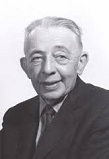
In 1951 Hungarian-born Am. psychologist Georg Katona (1901-81) pub. Psychological Analysis of Economic Behavior, about his late 1940s U. of Mich. Consumer Index, which applies psychology to macroeconomics, and successfully predicted the post-WWII boom in the U.S.; "Business is like sex. When it's good its very, very good; when it's not so good, it's still good."
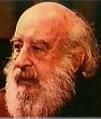
In 1951 Berlin, Germany-born psychiatrist Fritz Perls (1893-1970) et al. pub. Gestalt Therapy: Excitement and Growth in the Human Personality, explaining Gestalt Therapy, which emphasizes enhanced awareness of the present moment.
In 1952 the first Diagnostic and Statistical Manual of Mental Disorders (DSM) is pub. by the Am. Psychiatric Assoc. (APA); it is revised in 1968, 1980/7, 1994, and 2000.

In 1952 Vienna, Austria-born economist-philosopher Friedrich August (von) Hayek (1899-1992) pub. The Sensory Order: An Inquirty into the Foundations of Theoretical Psychology, which expands Hebbian synapse theory into a global brain theory; claims that perception cannot be accounted for by means of physical laws, since the effect of sensory stimulus is the first aspect of the complex order of perception, after which the mind maps the order of the external stimulus; this perceptual experience, however, is not identical to any other from a similar external stimulus since each has its own character in relation to the associations that the mind assigns to any particular sensory experience, and our perception of external objects are "never of all the properties which a particular can be said to possess objectively, not even only some of the properties which these objects in fact possess physically, but always on certain aspects, relations to other kinds of objects which we assign to all elements of the classes in which we place the perceived objects."


In Mar. 1952 Am. journalist William Hollingsworth "Holly" Whyte Jr. (1917-99) coins the term "Groupthink". In Nov. 1971 Buffalo, N.Y.-born psychologist Irving Lester Janis (1918-90) pub. the article "Groupthink" in Psychology Today, recoining the term, and going on to pub. Victims of Groupthink (1972), Decision Making: A Psychological Analysis of Conflict, Choice, and Commitment (1977), Groupthink: A Psychological Study of Foreign Policy Decisions and Fiascoes (1982), and Crucial Decisions: Leadership in Policymaking and Crisis Management (1989).


Just the man for them pesky Commie banana republics? On Feb. 26, 1953 Gen. Walter Bedell Smith resigns, and his deputy (since Aug. 1951) Allen Welsh Dulles (1893-1969) (brother of John Foster Dulles) is appointed dir. #5 of the CIA (until Nov. 29, 1961) (first civilian and longest serving dir. until ?), rising to the top of the U.S. spy chain during the Cold War; on Apr. 13 he authorizes the secret Project MKUltra in Montreal, Canada, which goes on to use humans as guinea pigs in an attempt to "crush the human psyche to the point that it would admit anything", "depatterning" and "psychic driving" patients by torturing them with electroshocks and drug-induced comas into a permanent coma etc.; in July 1963 it pub. the KUBARK Counterintelligence Interrogation Manual; the tortures are run by Scottish-born psychiatrist Donald Ewen Cameron (1906-67), pres. of the Am. Psychiatric Assoc. (APA) in 1952-3.
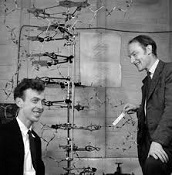


The Science of Biology gets its Trinity of Watson-Crick-and-I-forget? On Feb. 28, 1953 Chicago-born U.S. biologist James Dewey Watson (1928-) and British Cambridge U. model-making molecular biologist Francis Harry Compton Crick (1916-2004) announce their discovery of "the secret of life", the neat transvestite double-helix structure of DNA, then pub. a 1-page article in the Apr. 25 issue of Nature, drooling "This structure has novel features that are of considerable biological interest", later sharing the 1962 Nobel Med. Prize for it with Kiwi physicist Maurice H.F. Wilkins (1916-2004), who verifies the structure with X-ray diffraction; meanwhile Wilkins' colleague Rosalind Elsie Franklin (1920-58) of Kings College, who also pub. an article in the Apr. 25 issue on her X-ray diffraction studies, and whose work allowed the discovery is left out of the prize - no wonder girls hate math?
In 1953 the Am. Psychological Assoc. (APA) develops a Code of Ethics for Psychologists.




In 1953 English anthropologist Gregory Bateson (1904-80) (husband of Margaret Mead), Am. anthropologist John Weakland (1919-95), and Am. psychiatrists Donald deAvila Jackson (1920-68), and Jay Douglas Haley (1923-2007) found the Bateson Project (ends 1963); in 1956 they pub. the paper Towards a Theory of Schizophrenia, which proposes the Double Bind Theory of Schizophrenia, where different or contradictory messages are received, founding Family Therapy. In 1962 Haley founds the family therapy journal Family Process.

In 1953 German psychologist (in the U.K.) Hans Jurgen Eysenck (1916-97) pub. the article "What is Wrong with Psychoanalysis", claiming that psychotherapy has no proven effect, and that psychoanalysis has negative effects; he goes on to devote his career to pioneering behavior therapy; too bad, he latches onto the idea that IQ has a genetic basis, causing a female protester to punch him in the face in 1973 at the London School of Economics; on May 11, 1995 he pub. his masterpiece Genius: The Natural History of Creativity, containing his final arguments for a genetic basis for intelligence, which later is found to have some evidence, but is correlated with higher risk for schizophrenia, autism, and bipolar disorder.

In 1953 after splitting with the Internat. Psychoanalytic Assoc. and Freud's "50-minute hour" with his variable-length session, renegade far-left French psychiatrist Jacques Marie Emile Lacan (1901-81) founds the Societe Francaise de Psychanalyse (Société Française de Psychanalyse) (SFP), giving seminars at Sainte-Anne Hospital for the next 27 years; in 1966 he pub. Ecrits (Écrits).

In 1953 Mount Vernon, N.Y.-born psychologist David Clarence McClelland (1917-98) pub. The Achievement Motive, followed in 1961 by The Achieving Society, proposing Need Theory, which claims that people who make good top mgt. material should have a high need for power and a low need for affiliation, but not necessarily a need for achievement.

In 1953 Hartford, Conn.-born epileptic patient Henry Molaison (1926-2008) has his temporal lobe resected and his hippocampus and amygdaloid complex removed by lobotomy by renowned neurosurgeon Dr. William Beecher Scoville, causing him to lose his ability to form new memories, making him into a celeb neuroscience patient.

In 1953 Norwich, N.Y.-born closet gay psychiatrist Harry Stack Sullivan (1892-1949) posth. pub. The Interpersonal Theory of Psychiatry, advocating the Self System which ditches the unconscious mind for direct verifiable observation of personality traits developed in childhood and reinforced by positive affirmation, along with the security operations developed to counter threats to self-esteem.

In 1954 Minneapolis, Minn.-born psychologist Paul Everett Meehl (1920-2003) pub. Clinical vs. Statistical Prediction: A Theoretical Analysis and a Review of the Evidence, which claims that mechanical (formal algorithmic) methods of data combination outperform clinical (subjective informal) methods when used to arrive at a prediction of behavior.

In 1954 Chicago, Ill.-born psychologist James Olds (1922-76) and Peter Milner of McGill U. discover the Brain Reward System in rats, involving the Brain Pleasure Center, driving drug addiction et al., later finding it in other animals and humans.


Speaking of the pleasure center of the brain? On Feb. 10, 1954 the U.S. govt. starts going after Austrian-born psychoanalyst Wilhelm Reich (1897-1957), who has been building and selling silly metal-plated wooden booths called Orgone Accumulators (the original porno peek booths?), seeking an injunction preventing their interstate shipment, incl. all associated lit.; after he fails to contest it, it is granted on Mar. 19 by the puppet judge, then used to have him arrested in May 1956, after which he dies in a federal pen, already neatly diagnosed by a govt. psychiatrist as "paranoia manifested by delusions of grandiosity and persecution and ideas of reference" - jailed for the federal crime of booth-shipping or a thought crime?

In 1954 Brooklyn, N.Y.-born psychologist Julian B. Rotter (1916-) pub. Social Learning and Clinical Psychology, founding Social Learning Theory. In 1966 he pub. a paper proposing the Internal-External Locus of Control Scale (I-E Scale).
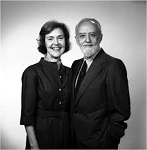
In 1954 the Robbers Cave Study sees married social psychologists Muzafer Sherif (1906-88) and Carolyn Wood Sherif (1922-82) take 22 11/12-y.-o. boys to a summer camp in Robbers Cave State Park, Okla., showing how they can go native and turn on each other "Lord of the Flies" style when divided arbitrarily into groups and given economic incentives, then watch them come together when water is withdrawn.




In 1954 Hartford, Conn.-born neuropsychologist Roger Wolcott Sperry (1913-94) becomes a prof. at Caltech, where he begins experiments on Split-Brain Research with students incl. Michael S. Gazzaniga (1939-). In 1981 Sperry shares the Nobel Med. Prize with David Hunter Hubel (1926-) and Torsten Nils Wiesel (1924-).

In 1954 Am. psychologist Herman A. Witkin (1916-79) pub. Personality Through Perception: An Experimental and Clinical Study, which claims that personality can be revealed through differences in how people perceive their environment; in 1962 he develops the Rod and Frame Test (RFT).




On June 7, 1955 the TV quiz show $64,000 Question, emceed by Hal March (1920-70) and sponsored by Revlon debuts on CBS-TV (ends June 1958); questions are written by prof. Bergen Baldwin Evans (1904-78); a new Cadillac is the consolation prize to those missing the big money question; New York City-born psychologist Dr. Joyce Brothers (1927-) wins in the category of boxing, Barbara Feldon (1933-) for Shakespeare; too bad, the TV quiz show scandal causes it to be cancelled, after which March is out of work for a decade, then dies of lung cancer; Brothers is permitted to be the first-ever woman boxing color commentator for CBS-TV during the match between Sugar Ray Robinson and Carmen Basilio, and in Aug. 1958 becomes the first TV psychologist.

In 1955 Philly-born linguist Avram Noam Chomsky (1928-) pub. The Logical Structure of Linguistic Theory, which challenges structural linguistics and introduces transformational (generative) grammar, consisting of a context-free grammar with transformational rules, positing a Language Acquisition Device (LAD) and a Universal Grammar (UG). In 1957 he pub. Syntactic Structures, which claims that human language is "hard-wired", and that there are only superficial variations among languages, starting a rev. in linguistics and taking it out of the "verbal botany" mindset; "Colorless green ideas sleep furiously." In 1957 Am. behaviorist psychologist B.F. Skinner (1904-90) pub. Verbal Behavior, which claims that it is subject to the same controlling variables as other operant behavior; in 1959 Noam Chomsky pub. Review: Verbal Behavior by B.F. Skinner, helping launch the Cognitive Rev. in psychology, which tries to overturn Behaviorism. In May 1965 he pub. Aspects of the Theory of Syntax, his magnum opus on linguistics, presenting his epistemological assumptions with the goal of making linguistic theory-making a discipline on a par with the physical sciences, dissing behaviorism, constructivism, empiricism, and structuralism in favor of generativism, mentalism, nativism, and rationalism, focusing on the inner workings of the human mind during language acquisition and production - the kind of book everybody wishes they could write but don't have the innate capacity?

In 1955 Fresno, Calif.-born psychologist Lee Joseph Cronbach (1916-2001) pub. Construct Validity in Psychological Tests, defining Construct Validity. In 1963 he pub. a paper defining Generalizability (G) Theory.

In 1955 Pittsburgh, Penn.-born psychologist Albert Ellis (1913-2007) develops Rational Emotive Behavior Therapy (REBT), a new more active-directive type of psychotherapy that seeks to help the client understand that his personal philosophy contains beliefs contributing to his own emotional pain, and change them; in 1982 a survey of U.S. and Canadian psychologists ranks him #2 in history after Carl Rogers, with Sigmund Freud #3.

In 1955 Santa Rose, Calif.-born psychologist John Garcia (1917-2012) pub. a paper about Taste Aversion AKA the Sauce-Bernaise Syndrome and the Garcia Effect.

In 1955 after helping the USAF develop the Stanine (Standard Nine) Scale for evaluating pilots in 1943, Marquette, Neb.-born psychologist Joy Paul Guilford (1897-1987) (student of Louis Leon Thurstone) proposes the Structure of Intellect (SOI) Theory of human intelligence, dividing it into 150 different abilities organized along the dimensions of Operations, Content, and Products; after becoming popular for use by the U.S. military, it is discredited by the 1990s.

In 1955 Am. psychologist George Alexander Kelly (1905-67) pub. The Psychology of Personal Constructs (2 vols.), founding Personal Construct Theory (PCT), which claims that psychology as a science must attempt to set in order the facts of human experience so that psychologists can make good predictions about what patients will do in new situations; "A person's processes are psychologically channelized by the ways in which he anticipates events."
In 1955 U.S. psychiatric clinics treat 233K patients; by 1977 it grows to 3.9M, with another 3M going to private therapists; the success rate is 0%?

In 1956 Lansford, Penn.-born educational psychologist Benjamin Samuel Bloom (1913-99) pub. Taxonomy of Educational Objectives: Book 1: Cognitive Domain, which becomes the bible for Am. educators, telling them to influence "the ways in which individuals are to act, think, or feel" using B.F. Skinner's operant conditioning methods; that the goal of education is to control "much of the individual's behavior" and to integrate "beliefs, ideas, and attitudes into a total philosophy or world view, with academics becoming secondary, resulting in U.S. education sliding down from its #1 position.

On Jan. 1, 1956 New York City-born social psychologist Leon Festinger (1919-89) et al. pub. When Prophecy Fails: A Social and Psychological Study of a Modern Group That Predicted the Destruction of the World, about a small cult called the Seekers led by Chicago, Ill. housewife (ex-Scientologist) Dorothy Martin (1900-92) that claimed to be receiving messages from the "Guardians" from another planet, who told them that a flood would destroy the world on Dec. 21, 1954; when it failed to materialize, instead of giving up their beliefs they claimed that the "Force of Good and Light" the members spread through the world caused it to be spared, and she changes her name to Sister Thedra and founds the Assoc. of Sananda and Sanat Kumara, which survives her death. In 1957 Festinger pub. his theory of Cognitive Dissonance.

In 1956 Ada, Ohio-born existential psychologist Rollo May (1909-94) pub. Existence, popularizing Existential Psychotherapy. In 1969 he pub. Love and Will, claiming that an awareness of death is essential to life.

In 1956 Charleston, W. Va.-born cognitive psychologist George Armitage Miller (1920-2012) pub. The Magical Number Seven, Plus or Minus Two: Some Limits on Our Capacity for Processing Information, showing an experimental average limit of seven plus or minus two for human short-term memory capacity, which becomes known as Miller's Law; "With binary items the span is about nine and, although it drops to about five with monosyllabic English words, the difference is far less than the hypothesis of constant information would require. The span of immediate memory seems to be almost independent of the number of bits per chunk, at least over the range that has been examined to date"; if info. is recoded into richer-content chunks, great memory feats can be performed; "It is a little dramatic to watch a person get 40 binary digits in a row and then repeat them back without error." In 1962 he pub. Psychology, the Science of Mental Life, rejecting the idea that psychology should only study behavior.



In 1957 Swedish scientist Arvid Carlsson (1923-) proves that dopamine is a brain neurotransmitter and not just a precursor to norepinephrine, winning him the 2000 Nobel Med. Prize. In 1967 Greek-born Am. neurologist George Constantin Cotzias (1918-77) develops L-Dopa (levo-3,4,-dihydroxyphenylalanine) therapy for dopamine-deficient patients suffering from manganese poisoning, gradually increasing the oral dosage so that they can develop tolerance to the toxic side effects until they get enough in their system to pass the blood-brain barrier and turn into dopamine. In 1973 London-born neurologist Oliver Wolf Sachs (1933-) pub. Awakenings, about his use of L-Dopa on encephalitis lethargica patients at Beth Abraham Hospital in Bronx, N.Y., which is filmed in 1990 starring Robin Williams and Robert De niro.


In 1957 Tacoma, Wash.-born child psychologist Eleanor Emmens Maccoby (1916-) et al. pub. Patterns of Child Rearing. In 1974 she and Chicago, Ill.-born psychologist Carol Nagy Jacklin (1939-2011) pub. The Psychology of Sex Differences, which becomes a big hit with academia and the gen. public. In 1998 she pub. The Two Sexes: Growing Up Apart, Coming Together.
In 1957 Imipramine (Melipramine) AKA Tofranil, the first Tricyclic Antidepressant (TCA) is discovered.
In 1958 John Cohen (1911-) pub. Humanistic Psychology, the first book on the subject.

On Aug. 31, 1958 Fairfield, Iowa-born psychologist Harry Harlow (Israel) (1905-81) of the U. of Wisc. gives the address "The Nature of Love" at the 66th Annual Am. Psychological Assoc. Convention in Washington, D.C., reporting on his cruel isolation experiments on infant macaque and rhesus monkeys, showing how they attach to cloth-wire mothers etc., creating a firestorm of controversy that helps spawn the animal liberation movement - have a nice life, dick?

In 1958 Bronxville, N.Y.-born psychologist Lawrence Kohlberg (1927-87) pub. his U. of Chicago doctoral dissertation, describing Kohlberg's Stages of Moral Development, identifying six developmental stages from obedience and punishment orientation to universal ethical principles or principled conscience.


In 1958 Aaron Bunsen Lerner (1920-2007) et al. at Yale U. isolate the hormone Melatonin from the pineal glands of rats, which turns out to regulate the Circadian Rhythm. In 1994 Japanese-born Am. neurobiologist Joseph Takahashi (1951-) discovers the genetic basis for the mammalian circadian clock, and in 1997 identifies the Clock gene.

In 1958 South African psychologist Joseph Wolpe (1915-97) pub. the paper "Psychotherapy by Reciprocal Inhibition", presenting his theory of Reciprocal Inhibition, leading to his theory of Systematic Desensitization for anxieties and phobias. In 1969 he develops the Subjective Units of Distress (Disturbance) Scale (SUDS).
In 1959 Am. psychologist Allen L. Edwards (1914-) (disciple of Henry Alexander Murray) develops the 15-category Edwards Personal Preference Schedule (EPPS).

In 1959 Am. mathematician Robert Duncan Luce (1925-2012) pub. Individual Choice Behavior: A Theoretical Analysis, which introduces Luce's Choice Axiom, which states that the probability of selecting one item over another is not affected by the presence or absence of other items in the pool, which becomes important in psychology and economics.

In 1959 Vienna, Austria-born Am. psychologist George Mandler (1924-) and Am. psychologist William Kessen (1925-99) pub. The Language of Psychology, arguing that psychology still doesn't have a precise enough language to formulate the essentials of the science. In 1980 Mandler pub. Recognizing: The Judgment of Previous Occurrence, claiming a dual process basis of recognition, first to determine prior occurrence then to identify.
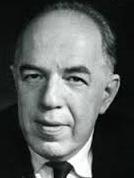
In 1960 Vienna, Austria-born English art historian Sir Ernst Hans Josef Gombrich (1909-2001) pub. Art and Illusion: A Study in the Psychology of Pictorial Representation, exploring the history of art in light of modern theories of visual perception, becoming a hit. He follows with The Sense of Order: A Study in the Psychology of Decorative Art (1979), and The Image and the Eye. Further Studies in the Psychology of Pictorial Representation (1982).

In 1960 German-born English pshrink Max Hamilton (1912-88) pub. the Hamilton Rating Scale for Depression (HRSD), with a score of 20+ indicating clinical depression.

In the early 1960s Providence, R.I.-born psychiatrist Aaron Temkin Beck (1921-) of the U. of Penn. develops Cognitive Therapy (CT), which works to identify and correct dysfunctional thinking, behavior, and emotional reponses.

In the 1960s Canton, Ohio-born psychologist Marshall B. Rosenberg (1934-) develops Nonviolent (Compassionate) (Collaborative) Communication (NVC), a conflict resolution process based on self-empathy, empathy, and honest self-expression. In 2003 he pub. Nonviolent Communication: A Language of Life, which disses the "Dominator Culture" that allows a minority to rule over the majority, advocating educational reforms incl. no grades, authority, labels, punishments, rewards, duty, or obligations.
The 1960s becomes the Pharamaceutical Decade as blood pressure, tranquilizer, and other drugs hit the market bigtime, starting with the anti-anxiety sedative-hypnotic drug Librium (Chlordiazepoxide) (AKA Librax, Libritabs, Mesural, Multum, Novapam, Sonimen, Tropium, Angirex, Elenium, Klopoxid et al.) of Roche Labs, which receives FDA approval on Feb. 24, 1960 - my mother used to look like this?

In 1960 afer expanding the Double Bind Theory to call the process of going mad an "incompatible knot", Scottish psychiatrist Ronald David Laing (1927-89) pub. The Divided Self: An Existential Study in Sanity and Madness, followed by Self and Others (1961), and Sanity, Madness and the Family: Families of Schizophrenics (1964), uses questionnaires and game theory to try to trace the cause of schizophrenia to the "family nexus", a dark arena where people play selfish games with each other.

In 1960 Plymouth, England-born psychoanalyst Donald Woods Winnicott (1896-1971) introduces the concept of the True Self and False Self, the latter being used to present a "polite and mannered attitude in public". In 1965 he pub. The Maturational Processes and the Facilitating Environment: Studies in the Theory of Emotional Development, on Object Relations Theory, introducing the concept of the Transitional (Comfort) Object, e.g., a security blanket or teddy bear. In 1971 he pub. Playing and Reality, claiming that insight in psychoanalysis is helpful when it comes to the patient as a playful experience of discovery.

In 1961 Alberta, Canada-born psychologist Albert Bandura (1925-) conducts the controversial Bobo Doll Experiment, which proves that people can learn not just by being rewarded and punished themselves (Behaviorism), but by watching somebody else being rewarded and punished (Observational Learning), founding Social Learning Theory. In 1963 he pub. Social Learning and Personality Development. In 1986 he pub. Social Foundations of Thought and Action: A Social Cognitive Theory, portraying people as self-organizing and self-regulating, proposing the concepts of Triadic Reciprocality, the connections between human behavior, environmental factors, and personal factors, and Reciprocal Determinism, the causal relations between those factors. In 1997 he pub. Self-Efficacy: The Exercise of Control.

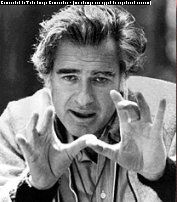

In 1961 Brooklyn, N.Y.-born psychiatrist Robert Jay Lifton (1926) pub. Thought Reform and the Psychology of Totalism: A Study of "Brainwashing" in China, which coins the term "brainwashing" AKA "thought reform" AKA "mind control", consisting of eight methods: milieu control, mystical manipulation, demand for purity, confession, sacred science, loaded language, subordination of person, right to dispense of existence; claims they can't permanently change beliefs or personality. On Oct. 24, 1962 John Frankenheimer's The Manchurian Candidate debuts, written by Frankenheimer and George Axelrod, based on the 1959 Richard Condon novel set in 1952; stars Frank Sinatra as Maj. Bennett "Ben" Marco, Laurence Harvey as Medal of Honor winner Raymond Shaw, Angela Lansbury as his Commie agent mother Mrs. Iselin, James Gregory as her Commie agent hubby U.S. Sen. John "Johnny" Iselin ("there are exactly 207, er, 104, er, 275 card-carrying members of the Communist Party in the State Dept."), and Janet Leigh as Sinatra's babe Eugenie "Rosie" Rose (Eldorado 5-9970) in an eerie mix of the Korean War, the McCarthy years, brainwashing theory, and the JFK assassination, which hasn't occurred yet, pissing-off both leftist and rightist critics while pleasing conspiracy theorists; Khigh Dhiegh plays Commie pshrink Yen Lo, Henry Silva plays Korean double agent Chunjin, John McGiver plays Sen. Thomas Jordan, Leslie Parrish plays his daughter Jocie; establishes TV dir. Frankenheimer as a film dir.; the Queen of Diamonds sets off Raymond Shaw's assassin programming mode; "Raymond Shaw is the bravest, kindest, warmest, most wonderful human being I've ever known in my life"; "Raymond Shaw, hell, hell" (ending).

In 1961 Milwaukee, Wisc.-born psychologist Neal Elgar Miller (1909-2002) proposes the use of Biofeedback to control heart rate and other involuntary functions.
In 1961 the Sleep Research Society (SRS) (originally the Assoc. for the Psychophysiological Study of Sleep) in Chicago, Ill. is founded, changing to its present name in 1982.

In 1962 Indian-born British psychoanalyst Wilfred Ruprecht Bion (1897-1979) pub. the paper A Theory of Thinking, in which he emphasizes that the mind grows through exposure to Truth, with mental development and truth being based on emotional experience, becoming known as one of those "inspired bizarre analysts... who demand not that their patients get better but that they pursue Truth." In 1962 he pub. Learning from Experience, followed by Elements of Psychoanalysis (1963), Attention and Interpretation (1970), and Experiences in Groups (1980), in which he proposes that every group is actually a work group and a basic assumption group, which works by dependency, fight-flight, and pairing. He goes on to be called "the greatest psychoanalytic thinker... after Freud" by Neville Symington.

In 1962 Philadelphia, Penn.-born child psychologist Leon Eisenberg (1922-2009) conducts the first randomized clinical trial of a psychiatric medicine; he goes on to promote the concept of Attention Deficit Hyperactivity Disorder (ADHD) in children, getting it accepted by the medical and pharmaceutical industries, becoming known as "the Father of ADHD"; ADHD is actually a fictitious disease that made him rich?

In 1962 Am. psychologist Sarnoff A. Mednick begins the longitudinal Copenhagen High-Risk-for Schizophrenia Study (ends 1986) of 207 children of women with schizophrenia starting at avg. age 15, disproving that schizophrenia is caused by low socioeconomic status, tracing it to enlarged cerebral ventricular enlargement caused by insults in utero.
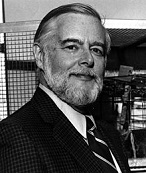
In 1962 Rochester, N.Y.-born psychologist Mark Richard Rosenzweig (1922-2009) discovers that rats placed in environmentally-enriched environments (toys, ladders, tunnels, wheels) increase their cerebral cortex volume, exploding the theory that brain structure is fixed by adulthood.

In 1962 Flushing, N.Y.-born psychologist Stanley Schachter (1922-97) and Jerome Singer propose the Two-Factor Theory of Emotion, which states that emotion is a function of both cognitive factors and physiological arousal; "People search the immediate environment for emotionally relevant cues to label and interpret unexplained physiological arousal."

In 1962 Philadelphia, Penn.-born psychologist Silvan Solomon Tomkins (1911-91) pub. Affect Imagery Consciousness (2 vols.), presenting Affect Theory, with affect meaning the "biological portion of emotion"; the Nine Affects are enjoyment/joy and interest/excitement (positive), suprise/startle (neutral), anger/rage, disgust, dissmell, distress/anguish, fear/terror, shame/humiliation (negative).

In 1963 Swiss psychiatrist Medard Boss (1903-90) pub. Psychoanalysis and Daseinsanalysis, which combines Ludwig Binswanger and Martin Heidegger to found a new type of psychotherapy called Daseinsanalysis.

In 1963 Metz, France-born Am. psychologist Bruno Furst (1891-1965) pub. You Can Remember! A Home Study Course in Memory and Concentration, explaining his mnemonic system for improving the memory.
On Feb. 5, 1963 Pres. John F. Kennedy sends a Special Message to Congress About the State of Mental Health, introducing legislation delegating the Nat. Inst. of Mental Health (NIMH) to administer community mental health centers for those discharged from state psychiatric hospitals.

In 1963 New York City-born social psychologist Stanley Milgram (1933-84) pub. an article about the Milgram Experiment, showing people obeying authority figures even when ordered to punish the innocent; the Lost Letter Experiment finds that letters addressed to "Friends of the Communist Party" etc. will be reposted far less than letters addressed to "Medical Research Associates" etc.

In 1964 Romanian psychologist-chemist Corneliu E. Giurgea (1925-95) synthesizes the learning-memory enhancing drug Piracetam; in 1972 he coins the term Nootropic for intelligence enhancing or smart drugs.
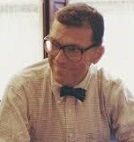
In 1964 Buffalo, N.Y.-born Duke U. social psychologist Edward Ellsworth "Ned" Jones (1926-93) pub. Ingratiation: A Social Psychological Analysis, which founds Ingratiation Theory, how one person ingratiates himself with another, going on to develop the theories of Fundamental Attribution Error (Correspondence Bias) (Attributin Effect) and Actor-Observer Bias (Assymetry).

In 1964 New York City-born statistician Joseph Bernard Kruskal Jr. (1928-2010) pub. a paper on Multidimensional Scaling, a set of techniques allowing a researcher to discuss the "hidden structure" of large databases. In 1978 he and Myron Wish pub. Multidimensional Scaling.

In 1965 Venice, Italy-born psychiatrist Roberto Assagioli (1908-74) pub. Psychosynthesis: A Collection of Basic Writings, describing Psychosynthesis, a spiritual holistic approach to psychology based on psychoanalysis, parting ways with his teacher Sigmund Freud by paying "far more attention to the higher unconscious and to the development of the transpersonal self. In one of his letters Freud said, 'I am interested only in the basement of the human being.' Psychosynthesis is interested in the whole building. We try to build an elevator which will allow a person access to every level of his personality." In 1974 he pub. The Act of Will.

In 1966 Terje Lomo of Norway first describes Long-Term Potentiation (LTP), the putative cellular mechanism of memory and learning, which he observes in a rabbit hippocampus.

In 1966 Vienna, Austria-born ethologist Konrad Zacharias Lorenz (1903-89) pub. On Aggression, about the four drives of hunger, reproduction, fear, and aggression within a species; discusses his Hydraulic Model of Instinctive Pressures, where aggression builds relentlessly until released, which is shared by Sigmund Freud.

In 1966 William Howell Masters (1915-2001) and Virginia Eshelman Johnson (1925-) pub. Human Sexual Response; clinically describes getting it on, based on porno shows, er, lab tests at Washington U. in St. Louis, Mo., with the sexual athletes hooked up to electrocardiographs et al.; claims that penis size is unimportant to most females - Virginia Masturbates William's Johnson? In 1970 they pub. the sequel Human Sexual Inadequacy, which disputes the concept of vaginal orgasm, claiming it's all in the clitoris, and that orgasms from lesbian, er, dildoes, er, masturbation are more intense than from heterosexual intercourse, plus, unlike male organs, women can have multiple orgasms in rapid succession - I just won the Big O lotto?


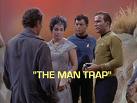
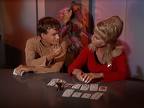


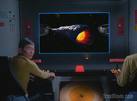
I'm a PC and I'm 8 years old? On Sept. 8, 1966 (Thur.) Star Trek: The Original Series, created by Tex.-born Eugene Wesley "Gene" Roddenberry (1921-91) debuts on NBC-TV for 79 episodes (until Apr. 4, 1969) with The Man Trap, starring Jeanne Bal (1928-96) as a shape-shifting salt-sucking space siren, unveiling a new technology-based Jesus-and-Muhammad-free futuristic leftist Jewish kingdom of heaven combined with a mostly white Wagon Train in Space show about the 23rd cent. voyages of the faster-than-light USS Enterprise NCC-1701, featuring Canadian Jewish actor William Shatner (1931-) as the straight womanizing swashbuckling Capt. James Tiberius Kirk (born in Riverside, Iowa), the Capt. Horatio Hornblower of Space, who is so good at his job that he's allowed to break the rules, incl. sex with blacks, browns, yellows, greens, blues, non-humans, anything they can sign an acting contract with; Jewish-Am. actor Leonard Nimoy (1931-) plays his 2nd in command, pointy-eared half-human half-Vulcan half-Salmon super-smart Science officer Spock (blood type T-negative) (only mates once every 11 years) (likes to put his hand in the shape of the Hebrew letter shin because in real life he's Jewish); Ga.-born actor DeForest Kelly (1920-) plays liquor-pouring Southern-drawling Dr. Leonard "Bones" McCoy, and Canadian actor James Doohan (1920-2005) plays Scottish engineer Scotty, who is the real brains of the ship, staying safely behind while the reckless captain and crew go beaming into danger and he takes the credit for superhuman repair work by inflating repair time estimates while swigging Scottish whiskey; on Sept. 15 episode #2 Charlie X stars Robert Hudson Walker Jr. (1940-), son of Robert Walker Sr. and Jennifer Jones as a space orphan raised by aliens who gets his first crush on a woman, Capt. Kirk's yeoman Janice Rand, played by Grace Lee Whitney (1930-), and can't grow up fast enough to avoid using his superhuman powers to destroy the ship until his alien parents intervene and take him back; in real life, Walker's mom Jennifer Jones cheated on his daddy then dumped him in 1945 for producer David O. Selznick, causing daddy to go nuts and become an alcoholic and have an early death in 1951, affecting him, while Whitney in real life was an orphan, and is cut from the show in the first season so that Kirk could have a guest babe each episode, causing her to spiral down also; episode #3 Where No Man Has Gone Before stars Gary Lockwood (1937-) as Lt. Cmdr. Gary Mitchell, who develops super-ESP when the Enterprise is driven over the edge of the galaxy; episode #9 Dagger of the Mind (Nov. 3) is about the Neural Neutralyzer Device; episode #28 The City on the Edge of Forever (Apr. 6, 1967), written by Harlan Ellison and featuring a working Historyscope called the Guardian of Forever plus yummy Joan Henrietta Collins (1933-) as Am. Depression Era social worker Edith Keeler wins a Hugo Award; episode #35 The Doomsday Machine (Oct. 20, 1967) about a planet-eating machine is written by Norman Spinrad; the show creates a new social class of fans called Trekkies (Trekkers), coined by Arthur William Saha (1923-99), incl. TLW, who took to emulating a Spock haircut in 9th grade (1967); too bad, after some go overboard, they get a bad name as nerdy escapist losers without a life; it's really an attempt to prepare youth for the New Age Movement?

In 1967 South African-born psychiatrist David Graham Cooper (1931-86) coins the term Anti-Psychiatry for the growing movement that regards psychiatrists as quacks or harmful.

In 1967 Cleveland, Ohio-born psychiatrist William Glasser (1925-) founds the Inst. for Reality Therapy, renamed the Inst. for Control Theory, Reality Theory and Quality Mgt. in 1994, and the William Glasser Inst. in 1996, teaching Reality/Control Theory, which is later renamed Choice Theory, teaching that mental illness is an expression of unhappiness, dissing conventional psychiatry for prescribing medications for mental illness, and advocating the consideration of mental health as a public health issue.

In 1967 Am. social psychologists Ernest Ellsworth "Ned" Jones (1927-93) and Victor Harris pub. a paper defining Fundamental Attribution Error (Correspondence Bias), underestimating the effect of the situation vis a vis the personality in explaining social behavior.

In 1967 Kiel, Germany-born Am. psychologist Ulric Gustav Neisser (1928-2012) pub. Cognitive Psychology, founding Cognitive Psychology, and coining the term. In 1976 he pub. Cognition and Reality: Principles and Implications of Cognitive Psychology, which criticizes the linear programming model of cognitive psychology. In 1979 he performs an experiment in which he shows subjects a video of two teams of students passing a basketball back and forth while a girl with an umbrella walks through the center, and finds that 79% fail to notice her because he asked them to count the number of basketball passes.


In 1967 Albany, N.Y.-born psychologist Martin E.P. "Marty" Seligman (1942-) begins experimenting on dogs, discovering that when they are unable to escape electric shocks they "learned helplessness". In 1998 he and Croatian-born Am. psychologist Mihaly Csikszentmihalyi (1934-) found Positive Psychology, "a psychology of positive functioning... which achieves a scientific understanding and effective interventions to build thriving individuals, families, and communities", and seeks "to make normal life more fulfilling" rather than just treating mental illness. In 2000 they pub. Positive Psychology: An Introduction. On Dec. 1, 1975 Csikszentmihalyi pub. Beyond Boredom and Anxiety: Experiencing Flow in Work and Play, followed by Flow: The Psychology of Optimal Experience (1990), outlining the theory of Flow, a state of complete absorption in an activity, in which people are happiest.

In 1968 Vienna, Austria-born Am. psychologist Walter Mischel (1930-) pub. the paper Personality and Assessment, criticizing Gordon Allport's works on trait assessment with the observation that a patient's behavior is not consistent across diverse situations but dependent on situational cues. In 1996 he pub. the book Personality and Assessment.
In 1968 the U. of Ill. at Urbana-Champaign establishes the first Doctor of Psychology (Psy. D.) prof. degree program.
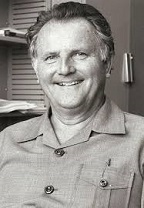
In Feb. 1969 San Diego, Calif.-born psychologist Arthur Robert Jensen (1923-2012) pub. the article How Much Can We Boost IQ and Scholastic Achievement? in the Harvard Educational Review, claiming that 80% of the variance of IQ in a pop. is the result of genetic factors, and only 20% to environmental influences, causing a firestorm of controversy along with death threats, causing him to pub. another article in 1981 with the soundbyte: "Nowhere have I 'claimed' an 'innate deficiency' of intelligence in blacks. My position on this question is clearly spelled out in my most recent book: 'The plain fact is that at present there exists no scientifically satisfactory explanation for the differences between the IQ distributions in the black and white populations. The only genuine consensus among well-informed scientists on this topic is that the cause of the difference remains an open question.'" In 1998 Jensen pub. The g Factor: The Science of Mental Ability, which claims there is a general factor of human mental ability forming a triangle of abilities, which should replace intelligence and IQ, likening it to a computer's CPU; his contention that gen. cognitive ability is an inherited trait, and that conceptual learning (synthesizing ability) occurs with greater frequency in whites than non-whites brings out the PC police; "The relationship of the g factor to a number of biological variables and its relationship to the size of the white-black differences on various cognitive tests (i.e., Spearman's hypothesis) suggests that the average white-black difference in g has a biological component. Human races are viewed not as discrete, or Platonic, categories, but rather as breeding populations that, as a result of natural selection, have come to differ statistically in the relative frequencies of many polymorphic genes. The genetic distances between various populations form a continuous variable that can be measured in terms of differences in gene frequencies. Racial populations differ in many genetic characteristics, some of which, such as brain size, have behavioral and psychometric correlates, particularly g. "

In 1969 London, England-born psychologist-psychiatrist Edward John Mostyn "John" Bowlby (1907-90) pub. Attachment and Loss (3 vols.) (1969, 1972, 1980), which introduces Attachment Theory, which claims that an infant needs to develop a relationship with at least one primary caregiver for normal development.

In 1969 Zurich, Switzerland-born physician Elisabeth Kubler-Ross (Kübler-Ross) (1926-2004) (one of identical triplets) pub. On Death and Dying: What the Dying Have to Teach Doctors, Nurses, Clergy, and Their Own Families, bout "out-of-body experiences" (astral projection), as told by dying hospital patients in one of the abba-dabba-do Five Stages of Grief (Kubler-Ross Model): Denial, Anger, Bargaining, Depression, Acceptance; spurs development of hospices for the dying - Science is getting close to finding the b.s. hormone?



In 1969 after founding the Journal of Humanistic Psychology in 1961, Abraham Harold Maslow (1908-70), Stanislav Grof (1931-), and Anthony J. "Tony" Sutich (1907-76) found the Journal of Transpersonal Psychology.



In 1969 the Assoc. for Women in Psychology (AWP) is founded, with Joann Evansgardner (1925-2010) as pres. #1; in 1970 members Phyllis Chesler (1940-) and Nancy M. Henley hijack an APA meeting to demand $1M in reparations for the damage that psychology has perpetrated against women.
In 1969 the Calif. School for Prof. Psychology (CSPP) is founded, becoming the first such school.


In Jan. 1970 LA-born Arthur Janov (1924) pub. The Primal Scream: The Cure for Neurosis, introducing Primal Therapy, an 8-mo. program of reexperiencing childhood pain and trauma, which he claims has a 100% success rate.
On Oct. 27, 1970 Pres. Nixon signs the U.S. Comprehensive Drug Abuse Prevention and Control Act, which incl. the U.S. Controlled Substances Act, establishing five categories of regulated drugs, with Schedule I created for those with no accepted medical use incl. LSD, Mescaline, Psilocybin, DMT, DMT, and Marijuana, shutting down medical research - and criminalizing so much human behavior that it fills the Bill of Rights with more holes than a Swiss cheese?
In 1971 the Leibniz Inst. for Psychology Info. at the U. of Trier is founded to pub. the PSYNDEX database of references to psychology in the German-speaking world.

In 1971 Pittsburgh, Penn.-born psychologist Sandra Ruth Lipsitz Bem (1944-) creates the Bem Sex Role Inventory, which incl. a scale for androgyny.

In 1971 Am. psychiatrist Peter Roger Breggin (1936-) founds the Center for the Study of Empathic Therapy, Education and Living to advocate reform in psychiatry, esp. its use of psychotropic drugs.

On Aug. 14-20, 1971 the Stanford Prison Experiment, run by New York City-born psychologist Philip George Zimbardo (1933-) sees students selected to play prisoners or guards; when the latter subject the former to psychological torture a little too readily, and one prisoner screams "I'm burning up inside!", the experiment is aborted; it later turns out to be a fraud.



In Nov. 1971 Am. neuroscientists John O'Keefe and Jonathan O. Dostrovsky pub. the paper The Hippocampus as a Spatial Map, announcing their discovery of the Place Cells in the hippocampus. In 1978 O'Keefe and Lynn Nadel (1942-) pub. The Hippocampus as a Cognitive Map, which claims that the hippocampus stores cognitive maps of portions of space; Nadel later proposes Multiple Trace Theory (MTT), which claims that the hippocampus is involved in episodic memory, while semantic memory is stored in the neocortex.

In 1972 after being wowed by the Synanon program, New York City-born psychiatrist Daniel Harold Casriel (1924-83) pub. A Scream Away from Happiness, describing the New Identity Process, group psychotherapy using screaming, hugging, and affirmation of basic needs, with all patient statements prefaced by "Fuck you!"; in 2001 the name is changed to Bonding Psychotherapy.

In 1972 Brooklyn, N.Y.-born psychologist (deputy of Sufi leader Idries Shah) Robert Evan Ornstein (1942-) pub. The Pyschology of Consciousness, about the use of biofeedback et al. to shift mood and awareness. In 1989 he and Paul Ralph Ehrlich (1932-) pub. New World, New Mind: Moving Towards a Conscious Evolution.

In 1972 Estonian-born Canadian psychologist Endel Tulving (1927-) pub. the distinction between episodic and semantic memory.
In 1973 the Doctor of Psychology (Psy.D.) degree and the Practitioner-Scholar Model are recognized by the Am. Psychological Assoc. (APA) at the Vail Conference on Levels and Patterns of Prof. Training in Psychology.

In 1973 Springfield, Mass.-born cultural anthropologist and Rankian psychologist Ernest Becker (1924-74) pub. The Denial of Death, in which he claims that a person's "primary repression" is knowledge of mortality, not sexuality like Freud said, and the denial of one's mortality is the basis of every person's character and causes much of the evil in the world; makes him an academic outcast until they award him the Pulitzer Prize 2 mo. after his death; "The emotional impoverishment of psychoanalysis must extend also to many analysts themselves and to psychiatrists who come under its ideology. This fact helps explain the terrible deadness of emotion that one experiences in psychiatric settings, the heavy weight of the character armor erected against the world."

In 1973 Am. journalist Flora Rheta Schreiber (1918-88) pub. Sybil: The Classic True Story of a Woman Possessed by Sixteen Personalities; bestseller (6M copies) about shy grad student Sybil Isabel Dorsett, whose real name is Shirley Ardell Mason (1923-98), and has DID (Dissociative Identity Disorder) (Multiple Personality Disorder) (Split Personality Disorder), 16 personalities incl. Victoria (Vicky), Peggy Lou (breaks glass), Mary (grandmother thinking), Vanessa; counseled by Dr. Cornelia Wilbur, who unifies her; filmed in 1976 starring Sally Field; in 1980 the Am. Psychiatric Assoc. officially recognizes DID, causing diagnoses to soar from 100 before this book is pub. to the thousands, leading to abuses incl. hysterical claims fo Satanic ritual abuse, after which in 1997 the APA issues a cautionary note, followed by a declaration in 1994 by the Am. Medical Assoc. (AMA) that recovered memories are "fraught with problems of potential misapplication"; in 1997 the British Royal College of Psychiatrists advises against the use of techniques to elicit recovered memories of abuse - then one day you turn on your radio and everything changes?


In 1973 Am. LSD-loving psychologist Timothy Francis Leary (1920-96) pub. Neurologic, followed in 1977 by Exo-Psychology: A Manual for the Use of the Human Nervous System According to the Instructions of the Manufacturers, and a Navigational Guide for Piloting the Evolution of the Human Individual, which describe his Eight-Circuit Model of Consciousness, eight brains that operate within the human nervous system, incl. the oral biosurvival circuit, emotional-territorial circuit, symbolic/neorosemantic-dexterity (time-binding) circuit, domestic/socio-sexual circuit, neurosomatic (rapture) circuit, neuroelectric/metaprogramming (telepathic) circuit, neurogenetic/morphogenetic (collective unconscious) circuit, and the psychoatomic/quantum nonlocal (overmind) circuit. In 1983 Robert Anton (Edward) Wilson (1932-2007) pub. Prometheus Rising, followed in 1990 by Quantum Psychology: How Brain Software Programs You and Your World, developing on it.

In 1973 Vygotsky Circle neuropsychologist Alexander Romanovich Luria (1902-77) pub. The Working Brain: An Introduction to Neuropsychology, claiming "three principal functional units of the brain whose participation is necessary for any type of mental activity", incl. the Waking Unit, the Info. Processing Unit, and the Mental Activity Unit; he also provides info. on rehabilitation of damaged brains; he also pub. the case studies The Mind of a Mnemonist: A Little Book About A Vast Memory (1968), and The Man with a Shattered World: The History of a Brain Wound (1972).

In 1973 Am. psychologist David Rosenhan (1929-2012 pub. the article "On Being Sane in Insane Places" in Science, desribing the Rosenhan Experiment, which finds that people with no mental problems can be admitted to psychiatric hospitals, and that when the hospitals are alerted that actors are applying, they falsely reject real patients.

On Dec. 15, 1973 after efforts by psychiatrist Dr. Robert L. Spitzer, the Am. Psychiatric Assoc. (APA) removes homosexuality from its Diagnostic and Statistical Manual of Mental Disorders II (DSM-II); in 2001 Spitzer pub. a paper claiming that highly motivated homos can change their sexual orientation to hetero, which the APA disavows as not being peer-reviewed - swallow or spitz jokes here?

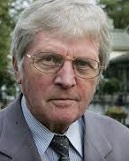

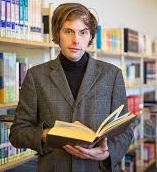
In winter 1974 Bristol-born English U. of Exeter and Ulster U. psychologist Richard Lynn (1930-) launches his career with a review titled A New Morality from Science: Beyondism in Irish Journal of Psychology, recommending that "incompetent societies have to be allowed to go to the wall" and "the foreign aid which we give to the under-developed world is a mistake, akin to keeping incompetent species like the dinosaurs which are not fit for the competitive struggle for existence", going to pub. studies claiming to find racial and gender differences in intelligence, bringing out the PC police. In 1997 he pub. Dysgenics: Genetic deterioration in modern populations, claiming guess what. In 2001 he pub. The Science of Human Diversity: A History of the Pioneer Fund. In 2001 he pub. Eugenics: A Reassessment, finding the prior work sound despite its rejection since WWII. On Nov. 10, 2006 he and Finnish sociologist Tatu Vanhanen (1929-2015) pub. IQ and Global Inequality. In 2006 Lynn pub. Race Differences in Intelligence: An Evolutionary Analysis (2nd ed. in 2015), a survey of 500+ articles, giving the avg. IQ scores of East Asians as 105, Europeans 99, the Inuit (91), Southeast Asians and native Ams. (87), Pacific Islanders (85), Middle Easterners (84), East and West AFricans (67), Australian Aborigines (62), and Bushmen and Pygmies (54), attributing poor nutrition to the lower range. In 2008 Lynn pub. The Global Bell Curve: Race, IQ and Inequality Worldwide, claiming to prove that U.S. IQ differences as detailed in the 1994 book "The Bell Curve" apply globally. On Feb. 28, 2002 Lynn and Vanhanen pub. IQ and the Wealth of Nations, claiming a correlation between IQ and per capita GDP. In 2012 Lynn and Vanhanan pub. Intelligence: A Unifying Construct for the Social Sciences. In Feb. 2014 Lynn and London-born anthropologist Edward Croft Dutton (1980-) pub. the study Why is intelligence negatively associated with religiousness? in the Interdisciplinary Journal on Research and Religion, claiming that physical scientists are more intelligent than social scientists, with the soundbytes: “There is sound evidence of a negative correlation between intelligence and religiosity and between intelligence and political extremism. Therefore the most probable reason behind elite social scientists being more religious than are elite physical scientists is that social scientists are less intelligent", "Intelligence is also a factor in interdisciplinary differences in political extremism, [with] physicists, who have high IQs, being among the least extreme and lower-IQ scholars being among the most extreme", and: "[Physical] scientists are overwhelmingly atheist. This is predicted by their high IQ, which allows you to rise above emotion and see through the fallacious, emotional arguments." On Jan. 2016 and German political scientist David Becker and Scottish IQ researcher Michael Anthony Woodley of Menie, Younger (1984-) of the Tech. U. of Chemnitz, Germany pub. the article It’s getting bigger all the time: Estimating the Flynn effect from secular brain mass increases in Britain and Germany in the journal Learning and Individual Differences, citing data from brains in the U.K. and Germany over the last 80 years to show that the Flynn effect of increasing generational IQ is accompanied by increased brain size, attributing 6%-13% to its contribution. On May 3, 2018 Lynn and Dutton pub. Race Differences in Psychopathic Personality: An Evolutionary Analysis, with the ad blurb: "This paper proposes that there are racial and ethnic differences in psychopathic personality conceptualised as a continuously distributed trait, such that high values of the trait are present in blacks and Native Americans, intermediate values in Hispanics, lower values in whites and the lowest values in East Asians. Part one of the paper sets out the evidence for this thesis. Part two applies the thesis to the unresolved problem in The Bell Curve that racial and ethnic differences in a number of social phenomena such as crime, welfare dependency, rates of marriage, etc. cannot be fully explained by differences in intelligence and proposes that some of the residual disparities are attributable to differences in psychopathic personality." In Apr. 2019 Lynn and Becker pub. The Intelligence of Nations, culminating their research efforts.
In 1974 the antidepressant drug (selective serotonin reputake inhibitor) Fluoxetine is discovered by Eli Lilly & Co.; the FDA approves it on Dec. 29, 1987, and it is marketed under the names Prozac, Sarafem, Fontex et al.; the patent expires in Aug. 2001.

In 1974 English psychologist Alan David Baddeley (1934-) and Graham Hitch of the U. of York develop Baddeley's Model of Working Memory, which postulates multiple short-term memory stores, and a separate system for manipulating their content; in 2000 he updates the model to include the Episodic Buffer to go with the Phonological Loop and the Visuo-Spatial Sketchpad.

In 1974 English zoologist Robert Aubrey Hinde (1923-) pub. Biological Bases of Human Social Behaviour - that's right, we're all really monkeys?

In 1974 St. Joseph, Mo.-born Shere Hite (1942-) pub. Sexual Honesty, By Women, For Women, claiming that 70% of women don't have orgasms through in-out intercourse with di, er, men, but do have them through clitoral masturbation.

In 1974 Los Angeles, Calif.-born psychologist Elizabeth L. Loftus (nee Fishman) (1944-) pub. the paper "Reconstructing Memory: The Incredible Eyewitness" on the malleability of human memory, going on to pub. papers on the Misinformation Effect and False Memory Syndrome and its relation to Recovered Memories.

In 1975 Polish-born Am. social psychologist Robert Boleslaw Zajonc (1923-2008) (pr. ZAY-unts) pub. the Confluence Model, showing how birth order and family size affect IQ. In 1980 he pub. the paper Feeling and Thinking: Preferences Need No Inferences, arguing that affective and cognitive systems are largely independent, and that the former is more powerful and important, reviving the study of emotion and affective processes.
In 1975 women break into U.S. and Canadian psychology big. The Task Force on the Status of Women in Canadian Psychology is formed, chaired by Mary Wright. The journal Sex Roles is founded. Psychology of Women Quarterly is founded, ed. by Georgia Babladelis. The first article on the psychology of women is pub. in Annual Review of Psychology. The first Psychology of Women Conference is held by the Am. Psychological Assoc. (APA). Signs: Journal of Women in Culture and Society, begins pub. by the U. of Chicago; Mary Parlee pub. the first review article on the psychology of women in it.

In 1976 Am. psychologist Julian Jaynes (1920-97) pub. The Origin of Consciousness in the Breakdown of the Bicameral Mind, which argues that until about 1,000 B.C.E. humans had no meta-awareness, i.e., awareness of awareness, but instead had a Bicameral Mind where neural activity in the dominant left hemisphere is modulated by auditory verbal hallucinations from the silent right hemisphere, which are taken as the voice of a chieftain or god and obeyed without question.

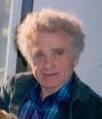
In 1976 mentally-ill scientist Eddie Oshins (1937-2003) founds Quantum Psychology, an extension of the Double Bind Theory of Schizophrenia with an explicit "principle of metalogical ambiguity" based on a work on "grey logic" of Soviet dissident physicist Yuri Feodorovich Orlov (1924-) that is smuggled out of his Soviet gulag written on toilet paper.


In 1976 Am. psychologist Michael I. Posner (1936-) pub. Chronometric Explorations of Mind, applying Franciscus Donders' Subtractive Method to study attention and memory. In 1994 he and Marcus E. Raichle pub. Images of Mind, using Positron Emission Tomography (PET) to localize cognitive brain functions.

In 1977 Susan Folstein and Michael L. Rutter (1934-) pub. a study of 21 British twins showing that autism in infants has a strong genetic factor.

In 1977 after conducting LSD research until it is outlawed, then switching to Holotropic Breathwork and co-founding Transpersonal Psychology, which promotes connectedness to a larger sense of being, recognition of the sacred, and a sense of quest, then being invited to the Esalen Inst. in 1973, Prague, Czech-born psychologist Stanislav Grof (1931-) founds the Internat. Transpersonal Assoc., devoted to mapping a person's emotional experiences onto his fetal and neonatal experiences to create a deep human psyche cartography, distinguishing between hylotropic (everyday) and holotropic (holisic) states of consciousness. In 1992 he pub. The Holotropic Mind: The Three Levels of Human Consciousness and How They Shape Our Lives, followed by The Ultimate Journey: Consciousness and the Mystery of Death (2006), LSD: Doorway to the Numinous: The Groundbreaking Psychedelic Research into Realms of the Human Unconscious (2009), Holotropic Breathwork: A New Approach to Self-Exploration and Therapy (2010), and Healing Our Deepest Wounds: The Holotropic Paradigm Shift (2012).

In 1977 Belleville, Ill.-born psychologist Ernest Ropiequet "Jack" Hilgard (1904-2001) pub. the paper Divided Consciousness: Multiple Controls in Human Thought and Action, which proposes his Hidden Observer Theory of Hypnosis.
In 1977 Russian psychiatrist Andrey Yevgenyevich Lichko (1926-94) pub. the paper Psychopathy and Accentuations of Character of Teenagers, which distinguishes psychopathy from accentuations of character.

In 1977 Chicago, Ill.-born psychologist Robert J. Plomin (1948-) proposes three major ways that genes and the environment interact to shape human behavior, passive, active, and evocative gene-environment correlation.

In 1977 after a 30-year study Alexander Thomas (1913-2003) of NYU pub. Temperament and Development, showing the importance of temperament for personality development, and how children tend to become like their parents.

In 1978 Glendale, Ohio-born Canadian child psychologist Mary Dinsmore Salter Ainsworth (1913-99) pub. Patterns of Attachment: A Psychological Study of the Strange Situation, discussing her Strange Situation Experiment (Protocol) and Attachment Theory.

In 1978 Paul Ekman (1954-) and Wallace V. Friesen pub. the Facial Action Coding System (FACS) to taxonomize human facial expressions; later used in the Fox Network TV show "Lie to Me" (2009-11).

In 1978 Am. psychologist David Premack (1925-) pub. the article Does the Chimpanzee Have a Theory of Mind?, coining the term Theory of Mind (ToM).

In 1978 Birmingham, Ala.-born sociobiologist Edward Osborne "E.O." Wilson (1929-) pub. the Pulitzer Prize-winning book On Human Nature, an attempt to reconcile humanism and science, founding Evolutionary Psychology (EP).

In 1979 Moscow, Russia-born Am. child psychologist Urie Bronfenbrenner (1917-2005) pub. The Ecology of Human Development: Experiments by Nature and Design, founding Ecological Systems Theory, which focuses on five environmental systems each individual interacts with: Microsystem, Mesosystem, Exosystem, Macrosystem, and Chronosystem.


In 1979 New York City-born physicist Douglas Richard Hofstadter (1945-) pub. Gödel, Escher, Bach: an Eternal Golden Braid (Pulitzer Prize); "A metaphorical fugue on minds and machines in the spirit of Lewis Carroll"; cool elaborate explanation of Godel's Incompleteness Theorem, which ultimately boils down to the limitations of finite numbers of words to completely describe truth?; claims that our sense of "I" comes from a "strange loop", which is "a level-crossing feedback loop"; "GEB is a very personal attempt to say how it is that animate beings can come out of inanimate matter. What is a self, and how can a self ome out of stuff that is as selfless as a stone or a puddle?" In 2007 he pub. I Am A Strange Loop, claiming that each human "I" is distributed over numerous brains; "In the end, we are self-perceiving, self-inventing, locked-in mirages that are little miracles of self-reference."


In 1979 Tel Aviv, Israel-born Am. psychologist Daniel Kahneman (1934-) and Haifa, Israel-born Am. psychologist Amos Nathan Tversky (1937-96) pub. On the Psychology of Prediction and Availability: A Heuristic for Judging Frequency and Probability, which establishes a cognitive basis for common human errors arising from heuristics and biases.

In 1979 Polish psychologist Alice Miller (nee Rostovski) (1923-2010) pub. The Drama of the Gifted Child: The Search for the True Self, followed by For Your Own Good: Hidden Cruelty in Child-Rearing and the Roots of Violence (1980), Thou Shalt Not Be Aware (1981), The Untouched Key: Tracing Childhood Trauma in Creativity and Destructiveness (1988), Banished Knowledge: Facing Childhood Injuries (1988), about her abused childhood and the "enlightened witness", Breaking Down the Wall of Silence: The Liberating Experience of Facing Painful Truth (1990), all dissing Freud and Jung for blaming the child for the sexual abuse of their parents, which she calls the "poisonous pedagogies".


In 1982 Am. feminist psychologist Carol Gilligan (1936-) pub. In A Different Voice: Psychological Theory and Women's Development, which disputes research by her colleague Lawrence Kohlberg (1927-87) that girls reach an avg. lower level of moral development than boys, and advocates "the ethics of care" over "the ethics of justice"; "The little book that started a revolution." (Harvard U. Press)


In 1982 British psychologist Richard Lynn (1930-) pub. an article in Nature noting that IQ scores have been systematically going up since 1950; in 1998 U.S.-born Kiwi political scientist James Robert "Jim" Flynn (1934-) pub. a paper on the same subject, getting the credit, and it becomes known as the Flynn Effect; between 1950-2000 IQ scores rise about 15 points.

In 1982 Am. physician John E. Sarno (1923-) pub. Mind Over Back Pain, promoting the controversial diagnosis of Psychosomatic Condition Tension Myositis Syndrome (TMS) AKA Tension Myoneuro Syndrome. He follows it with Healing Back Pain: The Mind-Body Connection (1991), The Mindbody Prescription: Healing the Body, Healing the Pain (1998), and The Divided Mind: The Epidemic of Mindbody Disorders (2006).
In 1983 the European Psychiatric Assoc. is founded.

In 1983 Scranton, Penn.-born child psychologist Howard Earl Gardner (1943-) pub. Frames of Mind: The Theory of Multiple Intelligences, disputing the g-factor theory with his Theory of Multiple Intelligences, with the soundbyte: "If we synthesise information from several disciplines, ranging from anthropology to brain study, it emerges that human beings are better described as having several relatively independent information processing capacities, which I call the 'multiple intelligences'."

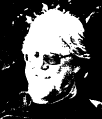
In 1983 W. David Pierce et al. pub. an article about Activity-Based Anorexia, caused by periods of pronounced food-related physical activity. In 1995 he and Frank Epling (1943-98) pub. Behavior Analysis and Learning, which becomes a std. textbook.

In 1984 Lebanon, Ore.-born neuroscientist Michael M. Merzenich (1942-) proves the existence of Neuroplasticity in the brains of owl monkeys; in 1988 he proves it in humans.

In 1984 English psychologist Peter Saville (1946-) et al. pub the Occupational Personality Questionnaire (OPQ), which measures the Big Five Personality Traits called OCEAN (openness to experience, conscientiousness, extraversion, agreeableness, neuroticism); Saville founds a co. that makes him a millionaire.
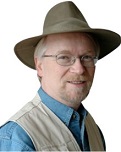
On Dec. 5, 1985 UCLA physics student Shawn Carlson (1960-) pub. the paper A double-blind test of astrology in Nature mag., proving that 28 top astrologers couldn't predict a person's personality based on date and time of birth better than random chance, effectively killing it as a serious scientific discipline.

In 1985 New York City-born psychiatrist Daniel N. Stern (1934-2012) pub. The Interpersonal World of the Infant, about the development of the four interrelated senses of self: emergent, core, subjective, verbal.

In 1985 Newark, N.J.-born psychologist Robert Jeffrey Sternberg (1949-) pub. Beyond IQ: A Triarchic Theory of Intelligence, explaining his Triarchic Theory of Intelligence, which breaks intelligence down into Componential/Analytical Subtheory, Experiential/Creative Subtheory, and Practical/Contextual Subtheory.


In 1986 Wessington Springs, S.D.-born David Everett Rumelhart (1942-2011) and Cambridge, Mass.-born James Lloyd "Jay" McClelland (1948-) pub. Parallel Distributed Processing: Explorations in the Microstructure of Cognition, about their computer models of perception incl. the first testable models of neural processing, becoming the bible of cognitive scientists.

In 1987 Buffalo, N.Y.-born physician Stuart Hameroff (1947-) pub. Ultimate Computing, which claims that subneuronal cytoskeleton components might be the basic units of information processing rather than neurons. In 1992 he meets Roger Penrose, and they formulate the Orchestrated Objective Reduction (Orch-OR) Model of Consciousness, which claims that microtubules are the site for the quantum mechanism of the brain; on Jan. 16, 2014 an article is pub. in Physics of Life Reviews corroborating their theory.


In 1987 Austrian-born Am. psychiatrist Karl H. Pribram (1919-) and Am. quantum physicist David Joseph Bohm (1917-92) (former asst. of Albert Einstein) propose the Holonomic Brain Model, which postulates that the brain stores all its info. about the past, present, and future in a "super hologram". In 1991 Bohm and Mark Edwards pub. Changing Consciousness: Exploring the Hidden Source of the Social, Political and Environmental Crises Facing Our World. In 1992 Bohm pub. Thought as a System.

In 1987 Palo Alto, Calif.-born Roger Newland Shepard (1929-) pub. the Universal Law of Generalization for Psychological Science.

In 1988 Phoenix, Ill.-born social psychologist Claude Mason Steele (1946-) proposes Self-Affirmation Theory.
In 1988 the Am. Neuropsychiatric Assoc. is founded.

In 1989 Swedish psychiatrist Lars Christopher Gillberg (1950-) pub. the first diagnostic criteria for Asperger Syndrome. In 2003 he leads a team that identifies the genetic mutations in individuals with autism, two genes on the X chromosome.
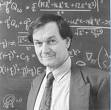
In 1989 English mathematical physicist Sir Roger Penrose (1931-) pub. The Emperor's New Mind, arguing that the mind's ability to best Godel's Theorem shows that it must have a quantum-level operation, which could be involved in the random choice of position when a quantum wave collapses into a particle.
On May 17, 1990 the World Health Org. (WHO) declassifies homosexuality as a mental disorder, causing annual celebration of the Internat. Day Against Homophobia, Biphobia and Transphobia (IDAHOBIT).

In 1990 Am. psychologist Leonard Berkowitz (1926-) pub. the Cognitive Neoassociation Model of Aggressive Behavior to cover the cases missed by the Frustration-Aggression Hypothesis.

In 1990 Japanese scientist Seiji Ogawa (1934-) discovers Functional MRI (fMRI), which uses blood oxygen levels to image the brain while performing various functions.

In 1991 after Pittsburgh, Penn.-born gay psychiatrist Richard Alexander Isay (1934-2012) threatens to sue them, the Am. Psychoanalytic Assoc. (APsaA) (founded 1911) changes its position statement on homosexuality and adopts a non-discrimination policy for trainees, and in 1997 becomes the first nat. mental health org. in the U.S. to support same-sex marriage. In 1992 U.S. psychoanalytic institutions agree to promote teachers and supervisors without regard to sexual orientation. In 1996 Isay pub. Becoming Gay: The Journey to Self-Acceptance, promoting the view that homosexuality is inborn, describing a developmental pathway specific to gay men, which is considered a breakthrough.
In 1991 the journal Feminism & Psychology is founded.

In 1992 Estonian-born Am. psychologist Jaak Panksepp (1943-) coins the term Affective Neuroscience for the field that studies the neural mechanisms of emotion, claiming that animals incl. rats have them; in 1998 he pub. Affective Neuroscience: The Foundations of Human and Animal Emotions; in 1999 he is featured in the documentary Why Dogs Smile and Chimpanzees Cry.
In 1992 after being accused by their adult daughter Jennifer, the False Memory Syndrome Foundation is founded by Pamela Freyd and Peter J. Freyd (1936-), who coin the term "False-Memory Syndrome" for people recalling false instances of sexual abuse during childhood.

In 1993 British psychologist Adrian Raine (1955-) pub. The Psychopathology of Crime: Criminal Behavior as a Clinical Disorder, claiming a biological-psychological basis for crime. In 2013 he pub. The Anatomy of Violence: The Biological Roots of Crime.

In 1994 British DNA man Francis Crick pub. The Astonishing Hypothesis: The Scientific Search for the Soul, which denies spirit in the functioning of the human mind, and contains the soundbytes: "A person's mental activities are entirely due to the behavior of nerve cells, glial cells, and the atoms, ions, and molecules that make them up and influence them", and "You, your joys and your sorrows, your memories and your ambitions, your sense of personal identity and free will, are in fact no more than the behaviour of a vast assembly of nerve cells and their associated molecules." In 1996 Australian philosopher David John Chalmers (1966-) counters with The Conscious Mind: In Search of a Fundamental Theory, which claims that all forms of physicalism fail to acocunt for the existence of consciousness itself.

In 1994 Lisbon, Portugal-born Am. neuroscientist Antonio Damasio (1944-) pub. Descartes' Error: Emotion, Reason, and the Human Brain, presenting the Somatic Marker Hypothesis (SMH) that rationality requires emotional input, hence Descartes was wrong to separate mind from body, and rationality from emotion. He follows this by The Feeling of What Happens: Body and Emotion in the Making of Consciousness (1999), Looking for Spinoza: Joy, Sorrow, and the Feeling Brain (2003), and Self Comes to Mind: Constructing the Conscious Brain (2010), about how the brain constructs the mind.



In 1994 New York City-born psychologist Richard J. Herrnstein (1930-94) and Newton, Iowa-born political scientist Charles Alan Murray (1943-) pub. the bestseller The Bell Curve: Intelligence and Class Structure in American Life, which pisses-off the PC police with the statement (ch. 13): "It seems highly likely to us that both genes and the environment have something to do with racial differences", after which 52 scientists sign Mainstream Science on Intelligence, an editorial by Linda Susanne Gottfredson (1947-) pub. on Dec. 13 in the Wall Street Journal backing the book up; duh, ch. 13 starts out: "The debate about whether and how much genes and environment have to do with ethnic differences remains unresolved."

In 1994 Montreal, Quebec-born psychologist Steven Arthur Pinker (1954-) pub. The Language Instinct, popularizing Noam Chomsky's innate faculty of mind theory and adding that language evolved by natural selection for communication, and isn't a by-product of other adaptations. In 1997 he pub. How the Mind Works, which claims that music is "auditory cheesecake", evolving by accident or serendipity. In 2002 he pub. the bestseller The Blank State: The Modern Denial of Human Nature, which argues against tabula rasa models of the social sciences, claiming that human behavior is shaped by Darwinian evolution.




In 1994 the "starvation hormone" Adiponectin, associated with fasting that controls sensitivity to insulin is discovered by Philipp Scherer; the appetite-suppressing hormone Leptin is discovered by Jeffrey M. Friedman (1954-), Rudolph Leibel (1942-), and Douglas L. Coleman (1931-). On Apr. 17, 2013 researchers at the U. of Tex. announce the identification of a protein that can block the brain's response to leptin.
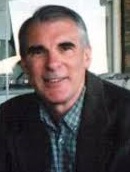
In 1995 English-born Canadian psychologist John Philippe Rushton (1943-2012) pub. Race, Evolution, and Behavior: A Life History Perspective (3rd ed. in 2000), claiming a global continuum of racial differences based on 60 variables, with Mongoloids at one end, Negroids at the other end, and Caucasoids in the middle, but closer to the Mongoloids, going on to hypothesize that the Negroids evolved 200K years ago, the Caucasoids 110K years ago, and the Mongoloids 41K years ago, with the soundbyte: "One theoretical possibility is that evolution is progressive and that some populations are more advanced than others", relating this to crime and AIDS rates, and the soundbytes: "Whites and East Asians have wider hips than Blacks... because they give birth to larger brained babies", and "Hormones that give Blacks an edge at sports makes them restless in school and prone to crime", pissing-off the PC police; "Unless one is a religious fundamentalist and believes that man was created in the image and likeness of God, it is foolish to believe that human beings are exempt from biological classification and the laws of evolution that apply to other life forms."

In Jan. 1996 R.P. Ebstein et al. pub. a study claiming that dopamine D4 receptor (DRD4) exon III polymorphism is associated with the human personality trait of novelty-seeking, causing Garret John LoPorto (1976-) in 2005 to pub. The DaVinci Method: Break Out & Express Your Fire, claiming that everybody with it can and should become a creative genius like Leonardo da Vinci. Too bad, in 2008 another study finds no effect, concluding that novelty-seeking behavior is probably mediated by several genes, and that the variance attributable to DRD4 is minor.

In Jan. 1996 British psychologist Christopher Richard "Chris" Brand (1943-2017) pub. The g Factor: General Intelligence and Its Implications, claiming that intelligence is heritable, immediately bringing the PC police (Anti-Nazi League) on it, causing the publisher John Wiley & Sons to withdraw it on Apr. 17 without explanation, although everybody knew why; "It is a very different book from the Bell Curve... Brand's book traverses every step of the chain of logic needed to see IQ as critical for social and educational policy: that there is something measurable called general intelligence ('g'), that differences in 'g' are strongly influenced by genetic factors (although Brand allows for environmental factors, he estimates that about 45 per cent of the variation in intelligence is due to 'narrow' genetic factors), and that 'g' is an accurate predictor of success in life. Along that chain there are far too many shaky steps for his thesis to be acceptable to many scientists, whether it is in the way IQ heritability is measured or the very debatable link between IQ and success." (New Scientist)
On June 13, 1996 the U.S. Supreme (Rehnquist) Court rules 7-2 in Jaffee v. Redmond to create a psychotherapist-patient privilege in the federal rules of evidence; Justice Antonin Scalia dissents, questioning the relative social importance of psychotherapy and the propriety of elevating pshrinks above "parents, siblings, best friends, and bartenders - none of whom was awarded a privilege against testifying in court", adding that Congress should create such a law, not the court.
On Sept. 26, 1996 Pres. William Clinton signs the U.S. Mental Health Parity Act, requring insurance co. coverage parity between mental health and other medical coverage; on Oct. 4, 2008 Pres. George W. Bush signs an amended version.

In 1996 Eunice, La.-born Joseph E. LeDoux (1949-) pub. The Emotional Brain: The Mysterious Underpinnings of Emotional Life, about the role of the amygdala, followed by Synaptic Self: How Our Brains Become Who We Are (2002), founding the rock group The Amygdaloids in 2006.

In 1996 Kiev, Ukraine-born Italian neurophysiologist Giacomo Rizzolatti (1937-) discovers Mirror Neurons.

In 1996 Israeli-born Am. psychologist Amos Nathan Tversky (1937-96) defines Ambiguity Aversion, the idea that people don't like ambiguous choices, relating it to comparative ignorance.
In 1997 UCLA neurosurgeon Itzhak Fried pub. a paper describing Syndrome E (Evil) that transforms people into repetitive killers after a "cognitive fracture" when the prefrontal cortex begins ignoring signals from more primitive brain regions.

In 1999 English philosopher George Botterill (1949-) pub. The Philosophy of Psychology, explaining the relationship between common sense or folk psychology and contemporary scientific psychology, focusing on the ways in which cognitive science challenges our common sense self-image.

In 1999 Am. social psychologists David Dunning (1960-) and Justin Kruger (1971-) pub. the paper Unskilled and Unaware of It: How Difficulties in Recognizing One's Own Incompetence Lead to Inflated Self-Assessments in Journal of Personality and Social Psychology, describing the Dunning-Kruger Effect, with the soundbyte: "People tend to hold overly favorable views of their abilities in many social and intellectual domains. The authors suggest that this overestimation occurs, in part, because people who are unskilled in these domains suffer a dual burden: Not only do these people reach erroneous conclusions and make unfortunate choices, but their incompetence robs them of the metacognitive ability to realize it." Guess who each side of the great climate debate claim it applies to?

In 2000 British psychologist Max Velmans pub. Understanding Consciousness, presenting his theory of Reflexive Monism, that the Universe is psycho-physical.
In 2002 the European Brain Council (EBC) is founded in Brussels, Belgium.
In 2002 the term for schizophrenia in Japan is changed from Seishin-Bunretsu-Byo (mind-split-disease) to Togo-shitcho-sho (integration disorder) to reduce stigma.

In 2002 Manhattan, N.Y.-born psychiatrist William S. Breitbart (1951-) develops Meaning-Centered Therapy for patients near the end of life, letting them rely on their spiritual beliefs.

In June 2002 after pub. a report in 1959 about walking through a public park dressed in a sheet like a ghost and nobody noticing, Cambridgeshire, England-born parapychologist Anthony Donald "Tony" Cornell (1924-2010) pub. Investigating the Paranormal, his magnum opus after 50 years of research, which finds that it's mostly bunk; "I take the view that the most nonsensical aspect of much of the physical phenomena in the seance room is the implicit notion that the discarnate resort to such ludicrous, absurd, and facile physical effects to prove that there is life after death. If, as claimed, life in the next world is more advanced than that on earth, one might be forgiven to expect proof of a more intelligent type than what appears acceptable to both the dead and the living, night after night, in the seance room. The shaking of tables and banging of tambourines, the creation of cold breezes and touches, trumpets cavorting and prancing about the room banging the heads of the sitters, and all the other antics that go on in the dark say little for the proficiency of the alleged discarnate visitors. If the "spirits" have been capable of such a momentous feat as surviving bodily death transcending time and manipulating matter in this world while existing in another dimension of time and space – why do they not materialize in the seance room something really worth the effort?"
On Sept. 10, 2003 Mark Achbar's and Jennifer Abbott's Canadian documentary The Corporation debuts, analyzing the modern corporation like a pshrink might do.
In 2003 the article Political Conservatism as Motivated Social Cognition is pub. in the Bulletin of the Am. Psychological Assoc., providing an alleged "elegant and unifying explanation" for political conservatism, claiming that it is "Significantly linked with mental rigidity and close-mindedness, increased dogmatism and intolerance of ambiguity, decreased cognitive complexity, decreased openness to experience, uncertainty avoidance, personal needs for order and structure, need for cognitive closure, lowered self-esteem; fear, anger, and aggression; pessimism, disgust, and contempt", linking Adolf Hitler and Benito Mussolini with Ronald Reagan because they're all "right-wing conservatives... because they all preached a return to an idealized past and favored or condoned inequality in some form", endung with the disclaimer that the study "does not mean that conservatism is pathological or that conservative beliefs are necessarily false, irrational, or unprincipled."

In 2003 British neurologist Natasha Campbell-McBride coins the term Gut and Psychology Syndrome (GAPS), for the connection between functions of the digestive system and brain.

On Jan. 9, 2005 Brooklyn, N.Y.-born psychiatrist Arnold M. Cooper (1930-2011) pub. The Quiet Revolution in American Psychoanalysis, essays about how psychiatry has evolved since Freud, plus his contributions in the area of narcissism and masochism.

In Apr. 2005 Hollywood actors Tom Cruise (Thomas Cruise Mapother IV) (1962-) and Kate Noelle "Katie" Holmes (1978-) go public with their relationship, smooching and posing for photographers in Rome; since they both have major movies in the works, critics label it a publicity stunt, but on June 17 they announce their engagement at the Eiffel Tower, and marry on Nov. 18, 2006 at Odescalchi Castle in Bracciano, Italy after she becomes a Scientologist, becoming known as Tomkat; on May 23 Cruise appears on The Oprah Winfrey Show to declare his love for "Dawson's Creek" actress Katie Holmes, jumping on Oprah's couch like a trampoline and hurting his image; on June 29, 2012 Holmes files for divorce, stating that she fears intimidation by the Church of Scientology, which she is leaving, and that Tom will abduct their daughter Suri (b. Apr. 2006). On June 24 Hollyweird and Scientology superstar Tom Cruise gives an interview to ABC-TV's Matt Lauer, dissing Brooke Shields for using anti-depressant drugs like Ritalin instead of vitamins and exercise for post-partem depression, calling Lauer "glib" for disagreeing, and uttering the soundbytes: "Before I was a Scientologist I never agreed with psychiatry, and when I started studying the history of psychiatry, I understood more and more why I didn't believe in psychology", "Psychiatry is a pseudo-science", and "You don't know the history of psychiatry, I do"; in 2008 Cruise apologizes for being "arrogant".
In May 2005 the Blue Brain Project is launched to reverse-engineer the mammalian brain down to the molecular level from lab data; on July 22, 2009 dir. Henry Markram of the Ecole Polytechnique in Switzerland utters the soundbyte: "It is not impossible to build a human brain and we can do it in 10 years."

In Sept. 2008 English neuroscientist Ben Michael Goldacre (1974-) pub. Bad Science, exposing medical fads and quacks incl. the Brain Gym, and dissing the medical profession for caving into drug co. pressure. On Sept. 25, 2012 he pub. Bad Pharma: How Drug Companies Mislead Doctors and Harm Patients, containing the soundbyte "The whole edifice of medicine is broken."
On Feb. 11, 2010 Neuron pub. an article by Cosimo Urgesi et al. of the U. of Udine in Italy linking a specific area of the human brain with the personality trait of self-transcendence.

On Oct. 5, 2010 Am. neuroscientist (atheist) Sam Harris (1967-) pub. The Moral Landscape: How Science Can Determine Human Values, which claims that science particularly neuroscience has something to say about morals.
In 2010 the Research Domain Criteria Project is launched by the U.S. Nat. Inst. of Mental Health (NIMH) in Bethesda, Md. to improve understanding of dimensional variables and brain circuits involved in mental disorders.
On Sept. 2, 2011 the Centers for Disease Control (CDC) pub. a Survillance Report on Mental Illness Among American Adults, with the soundbyte: "Published studies report that about 25% of all U.S. adults have a mental illness and that nearly 50% of U.S. adults will develop at least one mental illness during their lifetime", calling for "surveillance efforts at the national or state level... directed toward documenting anxiety disorders."

In Nov. 2011 Am. anthropologist Terrence William Deacon pub. Incomplete Nature: How Mind Emerged from Matter, which claims that the Theory of Everything that's being developed by scientists makes it "absurd that we exist", and offers the solution that the properties of mind emerge from a higher-order reciprocal relationship between self-organizing processes.
On Apr. 10, 2012 Michel Poulin and Anneke Buffone of the U. of Buffalo, and E. Alison Holman of UCI pub. an article in Psychological Science, announcing the possible discovery of a "niceness gene".
On May 18, 2012 Am. psychiatrist Robert Leopold Spitzer (1932-) apologizes for for his "fatally flawed" 2001 study that claimed that gays could be "cured".
On Mar. 27, 2013 researchers at the U. of Liege in France announce that Near-Death Experiences (NDEs) are produced by physiological mechanisms that lead to a more vivid perception of real and imagined events.
On Apr. 2, 2013 Pres. Obama announces the $3B 10-year BRAIN Initiative (Brain Activity Map Project) to map the activity of every neuron in the human brain. On Apr. 2, 2013 an article in Lancet claims that there is a continuum among neurodevelopmental and psychiatric disorders, which should be considered as different manifestations of a common "developmental brain dysfunction". On Apr. 4, 2013 researchers in Japan report in Science that they can predict dream imagery with 60% accuracy using fMRI scans.
On Apr. 7, 2013 T.L. Winslow (TLW) announces that the human mind is a quantum entanglement device.
On Apr. 10, 2013 Tor Wager et al. pub. a paper in the New England Journal of Medicine claiming that they can pinpoint what pain looks like in the brain using fMRI brain scans. On Apr. 16 scientists at Stanford U. announce the location of a brain "hot spot" responsible for numeral recognition. On Apr. 17 neuroscientsts at Case Western Reverse U. announce an efficient and reliable method of analyzing brain activity to detect autism in children. On Apr. 24 a study is pub. by Jean Decety et al. of the U. of Chicago that uses fMRI to find that psychopaths lack basic neurophysiological hardwiring to have concern for others.

On Apr. 30, 2013 famous Am. autistic activist Temple Grandin (1947-) pub. The Autistic Brain: Thinking Across the Spectrum; "Ignorance has become part of a society's belief system."
On May 15, 2013 Michael Fanselow and Moriel Zelikowsky of UCLA and Bryce Vissel of the Garvan Inst. of Medical Research pub. a paper revealing that parts of the prefrontal cortex take over when the hippocampus is disabled, becoming the first demonstration of neural circuit plasticity. On May 16 Tazu Aoki and Hitoshi Okamoto of the Laboratory for Developmental Gene Regulation pub. an article in Neuron that shows for the first time how info. stored as long-term memory in the cerebral cortex is processed to guide behavioral choices. On May 16 Current Biology pub. an article showing that Transcranial Random Noise Stimulation (TNRS) can cause long-term improvements in cognitive and brain function. On May 16 Stephen Palmer of UCB pub. an article in Proceedings of the Nat. Academy of Sciences showing that people pair music and colors the same across individuals and cultures.

On May 2, 2013 Gary Greenberg pub. The Book of Woe: The DSM and the Unmaking of Psychiatry, about the long tortuous road to DSM-5; "In my practice, it has virtually no clinical value. Its primary value is its ability to help patients use their insurance to pay for therapy." On May 8 Alison L. Barth of Carnegie Mellon U. pub. an article in Journal of Neuroscience revealing that neuronal development has an intermediate phse during which repeated exposure to a stimulus shrinks rather than lengthens synapses, showing the futility of all-night cram sessions. On May 22 despite disagreement in how to define psychiatric illnesses, DSM-5 is pub. by the Am. Psychiatric Assoc. (APA), retaining 10 personality disorders, and renaming pedophilia into Pedophilic Disorder. On May 21 scientists at John Hopkins School of Medicine pub. an article in Psychopharmacology reporting that the "magic mushroom" psilocybin delivered in the right dose can bring psychological health improvements. On May 23 an article by Duje Tadin and Michael Melnick of the U. of Rochester in Current Biology reports a link between IQ and motion filtering. On May 23 Owen Wolfkowitz et al. of UCSF reports to the Am. Psychiatric Assoc. (APA) in San Francisco that patients with major depression have greater activity of the enzyme telomerase in their immune system cells, indicating an attempt to fight back. On May 27 a report by the Centers for Disease Control (CDC) claims that one-fifth of U.S. kids have mental disorders, costing $247B a year. On May 28 Peter Walter of UCSF et al. pub. a study in eLife, reporting that the chemical ISRIB counters the effects of ElF2 alpha inactivation inside brain cells of mice, boosting memory. On May 29 Wellcome Trust in London announces the result of a preliminary trial indicating that an Avatar can help schizophrenics manage imaginary voices. On May 29 researchers at the U. of Tex. Galveston pub. a paper tying brain injury to a toxic form of tau units called oligomers.
On June 3, 2013 Idan Shalev et al. of Duke pub. an article in Psychological Science, reporting that the width of blood vessels in the retina may indicate brain health years before the onset of dementia. On June 4 Sally Satel and Scott O. Lilienfeld pub. Brainwashed: The Seductive Appeal of Mindless Neuroscience, about the abuse of fMRI. On June 5 researchers at Oxford U. pub. a study that finds that a "belief in science" helps non-religious/atheist people deal with adversity by giving them comfort and reassurance. On June 6 researchers at Weill Cornell Medical College pub. an article in Cell reporting the discovery of a mechanism that guides the wiring of neural circuits in a developing brain. On June 6 Jonas Frisen et al. of the Karolinska Inst. pub. an article in Cell reporting the use of C14 dating to establish that about 1.4K new neurons are created in the hippocampus each day during adulthood, with the rate declining modestly with age. On June 7 Dennis O'Leary et al. of the Salk Inst. for Biological Studies pub. an article in Science announcing that input from the thalamus is required to determine how the cerebral cortex grows into separate functional areas, not genes alone. On June 9 Steve Finkbeiner et al. of Gladstone Insts. pub. an article in Nature Neuroscience reporting that the protein called Arc controls homeostatic scaling of synapses to form long-term memories without causing epileptic seizures. On June 10 Leon Petchkovsky pub. an article in Journal of Analytical Psychology that reveals a 3-sec. conflict between the left and right brain caused by some trigger words, after which the left brain takes over to ensure that the "hot buttons" will continue to be active. On June 12 researchers at the U. of Penn. pub. a study in the Journal of Neuroscience that finds that a father's life stress exposure leaves a mark on his sperm that can affect the brain development of his offspring. On June 12 Sara C. Mednick of UCR, and Erik J. Kaestner and John T. Wixted of UCD pub. an article in Journal of Cognitive Neuroscience that finds that sleep spindles (burst of brain activity for 1 sec. of less) play a role in emotional memory, and that zolpidem (Ambien) heights the recollection of and response to negative memories. On June 13 Yu Fu and Richard Depue of Cornell U. pub. an article in Frontiers in Human Neuroscience that an experiment on 70 people using Ritalin showed that extroverts prefer immediate gratification and focus more on faces than introverts, who are overwhelmed by too much stimulation, pay more attention to detail, and have increased brain activity when processing visual info. On June 15-16 Oxford U. prof. Roger Penrose presents a theory at the Global Future 2045 Internat. Congress in New York City that the brain might act like a quantum computer, with the fibers inside neurons forming the basic units of quantum computation. On June 17 Stuart A. Lipton et al. at Sanford-Burnham Medical Research Inst. announce NitroMemantine, the first experimental drug to boost brain synapses lost in Alzheimer's disease. On June 17 Stefan Ropke et al. of the Charite Dept. of Psychiatry pub. an article in Journal of Psychiatric Research that finds using fMRI that persons suffering from narcissistic personality disorder have a deficit of thickness in the region of the cerebral cortex involved in the processing and generation of compassion. On June 19 Don Arnold and Richard Roberts of USC pub. an article in Neuron that reports how they have created microscopic probles that light up synapses in a living neuron in real time by attacking fluorescent markets to synaptic protons. On June 19 scientists at Carnegie Mellon U. pub. an article in PLOS ONE reporting that they have identified which emotion a person is experiencing based on brain activity as measured by functional MRI. On June 19 Bruce Donald et al. of Duke U. pub. an article in PLOS ONE reporting that they can use carbon nanotubes like harpoons to record electrical signals from individual neurons. On June 21 researchers from Germany and Canada pub. an article in Science announcing BigBrain, a 3-D digital model of the human brain at a spatial resolution of 20 microns. On June 21 scientists at the Scripps Research Inst. (TSRI) pub. an article in Journal of Neuroscience that a single gene mutation can destroy a key "window" of brain development permanently. On June 26 Albert Newen and Luca Barlassina of Ruhr-Universitat Bochum pub. an article in Philosophy and Phenomenological Research announcing their new theory that emotions are a separate kind of mental state arising through the integration of feelings of bodily processes and cognitive contents. On June 27 Christopher Berger of the Karolinska Inst. in Sweden pub. an article in Current Biology describing a study that found that what a person imagines hearing or seeing can change actual perception of the other sensory organ. On June 27 Robert Hanlon et al. of Northwestern U. pub. an article in Criminal Justice and Behavior finding that impulsive murderers are much more cognitively impaired than premeditated murders, who may also suffer from psychiatric disorders. On June 27 Anatol Kreitzer of Gladstone Inst. and Edward Callway of Salk Inst. pub. an article in Neuron anouncing a high-resolution mapping technique that uncovers the underlying circuit architecture of the brain. On June 28 Randy Bruno and Christine Constantinople of Columbia U. pub. an article in Science that reports that sensory info. travels two places at the same time, not only to the brain's mid-layer for deeper transmission in a serial fashion, but directly to the deeper layers. In June Gastroenterology pub. a study by scientists at UCLA proving that bacteria ingested in food can affect brain function in humans.
On July 1, 2013 Michael S. Gaffrey et al. at Washington U. in St. Louis pub. an article in Journal of the Am. Academy of Child & Adolescent Psychiatry revealing brain differences in preschoolers who are depressed. On July 3 Elizabeth Gould et al. of Princeton U. pub. an article in Journal of Neuroscience that reports that mice allowed to exercise regularly reorganize their ventral hippocampuses to reduce anxiety in response to stress and anxiety. On July 5 Matthew Lieberman, Emily Falk et al. of UCLA pub. an article in Psychological Science describing a study that indicated that the temporoparietal junction and dorsomedial prefontal cortex are associated with the successful spread of ideas AKA buzz. On July 8 psychologists Michael J. Wood and Karen M. Douglas of the U. of Kent pub. What About Building 7? A Social Psychological Study of Online Discussion of 9/11 Conspiracy Theories, which finds that those labeled conspiracy theories are saner than those who accept the official versions of contested events. On July 12 Toshiyuki Hirabayashi et al. of the U. of Tokyo pub. an article in Science revealing that the brain processes complex stimuli more cumulatively than previously thought, attaining detailed representations of objects not by building up representations in a single area, but by emergence of these representations in a hierarchically prior area and subsequent transfer to the brain region that follows until they become sufficiently prevalent for the brain to register them; the study also reveals that the brain activity involved in recreating visual stimula emerges in a hierarchically lower brain area than previously thought. On July 16 Mark Scott of the U. of British Columbia pub. an article in Psychological Science revealing evidence that a brain signal called corollary discharge plays an important role in experiences of internal speech. On July 18 Stuart Hameroff et al. of the U. of Ariz. pub. an article in Brain Stimulation reporting that transcranial ultrasound affects mood, with 30 sec. at 2Mhz giving the best positive mood change. On July 22 Marco Catani et al. of King's College, London pub. an article in Proceedings of the Nat. Academy of Science reporting their mapping of the neural pathways involved in word-learning in humans, finding that the arcuate fasciculus, which connects auditory regions in the temporal lobe with the motor area of the left hemisphere frontal lobe allows the sound of a word to be connected to the regions responsible for its articulation. On July 23 Birgit Wagner, Andrea B. Horn, and Andreas Maercker at the U. of Zurich pub. an article in the Journal of Affective Disorders providing evidence that Internet-based psychotherapy is as good or better than the face-to-face kind. On July 29 researchers at UCLA and UNC pub. a study that indicates that happiness affects one's genes in their immune cells.
On Aug. 8, 2013 Dolores Albarracin of the U. of Penn. and Justin Hepler of the U. of Ill. pub. an article in Cognition reporting that subliminal messages can unconsciously save a person from temptation. On Aug. 9 Simon Baron-Cohen et al. of Cambridge U. pub. an article in Brain reporting that autism affects different parts of the brain in women and men, and that females with autism show neuroanatomical "masculinization". On Aug. 14 Jeff Anderson et al. of the U. of Utah pub. an article in PLOS ONE reporting that brain imaging experiments find no evidence that some people are "right-brained" or "left-brained". On Aug. 20 Alexander B. Niculescu III et al. of Indiana U. pub. an article in Molecular Psychiatry reporting the finding of a series of RNA biomarkets in blood that might help identify people at risk for committing suicide. On Aug. 22 Peter Liddle et al. of the U. of Nottingham pub. an article in Neuron that the severity of symptoms incl. delusions and hallucinations in schizophrenics is caused by a disconnect between two regions in the brain, the insula and the lateral frontal cortex. On Aug. 27 Mazahir T. Hasan of the Max Planck Inst., Jose Maria Delgado-Garcia of the U. of Pablo de Olavide in Seville, Spain et al. pub. an article in Nature Communications reporting that some long-term memories are stored in the cortex not the hippocampus. On Aug. 29 Norman M. Weinberger et al. of UC Irvine pub. an article in Neuroscience reporting that specific memories can be made by directly altering brain cells in the cerebral cortex of rodents.
On Sept. 6, 2013 pub. B.M. Harvey of the U. of Utrecht et al. pub. an article in Science reporting the discovery of small brain area which represents numerosity along a continuous "map".
On Oct. 26, 2013 Spencer Smith et al. of UNC pub. an article in Nature reporting that dendrites in the brain actively process info., multiplying the brain's computing power.
On Jan. 2, 2014 Japanese scientists Kazuya Iwamoto et al. pub. an article in Neuron announcing that a class of junk DNA retrotransposons called Long Interspersed Nuclear Elements (LINE) might be responsible for schizophrenia. On Jan. 15 s Bijan Pesaran et al. of NYU pub. an article in Nature revealing that humans use both sides of their brains for speech.
On Mar. 1, 2015 Psychology Today announces that it will no longer carry ads for gay conversion therapy, and is deleting medical practitioners whose profile lists such therapy. On Aug. 7 by a 156-1 vote the Am. Psychological Assoc. (APA) bars psychologists from participating in nat. security interrogations at sites violating internat. law, causing the Pentagon to order the number of pshrinks at Gitmo to be reduced in Dec. On Aug. 27 Brian Nosek of the U. of Va. et al. pub. an article in Science revealing that only 39 of 100 studies pub. in major psychology journals could be replicated. On Oct. 23 Corinna E. Lockenhoff et al. of Cornell U. pub. an article in Evolution & Human Behavior revealing a study of 1K hetero men and women that finds that people with certain extreme pathological personality traits have more mates and children - wish I could fly like Superman?
In Feb. 2017 Am. neurologist Richard Saul pub. ADHD Does Not Exist: The Truth About Attention Deficit and Hyperactivity Disorder.
On Dec. 17, 2018 Max Rollwage, Raymond J. Dolan, and Stephen M. Fleming pub. the paper Megacognitive Failure as a Feature of Holding Radical Beliefs in Current Biology, revealing that people with radical beliefs they can't change have less metacognitive sensitivity, the ability to reflect on their cognitive processes.
On Jan. 8, 2019 the Am. Psychological Assoc. (APA) issues guidelines on men and boys, linking the "masculinity ideology" to homophobia and misogyny, with the soundbytes: masculinity ideology is defined as "a particular constellation of standards that have held sway over large segments of the population, including: anti-femininity, achievement, eschewal of the appearance of weakness, and adventure, risk, and violence"; "Traditional masculinity ideology has been shown to limit males' psychological development, constrain their behavior, result in gender role strain and gender role conflict and negatively influence mental health and physical health."
In July 2019 the Am. Psychological Assoc. (APA) establishes a Consensual Non-Monogamy Task Force to promote "polyamory, open relationships... and swinging", pissing-off the Catholic League and the Ruth Inst.
On Sept. 1, 2020 the Am. Psychological Assoc. (APA) issues a statement condemning institutional racism and calling for a "true systemic change in U.S. culture", with the soundbyte: "Every institution in America is born from the blood of white supremacist ideology and capitalism - and that’s the disease."